GALLERY
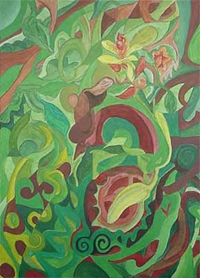 [Above] "The secret life of plants" (Artist, James Benton, 2001)
[Above] "The secret life of plants" (Artist, James Benton, 2001)
 Mangōtipi kōwhaiwhai pattern
Mangōtipi kōwhaiwhai pattern
(Mataatua)

[Above] "The Clampdown Revisited"
Talk given at Kia manawa pīharau Symposium
May 1, 2024
(See news for April-June 2024)
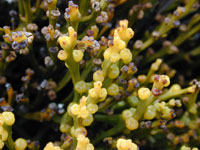
[Above] Psilotum nudum, a primitive fern
ally found throughout Polynesia.
Photo: (c) Forest & Kim Starr.
(See news for October 2023)
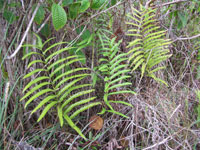
[Above] Cyclororus interruptus
a fern found in Aotearoa and Luangiua.
Photo: (c) Forrest & Kim Starr.
(See news for October 2023)
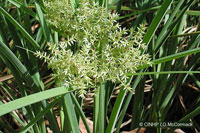
[Above] Cyperus javanicus
Mahelehele (Tonga)
Photo: (c) Forest & Kim Starr.
(See news for October 2023)
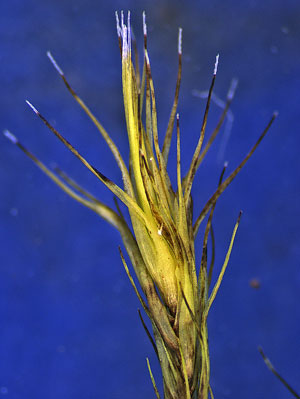
[Above] 1-Campylopus clavatus
a NZ moss closely related to
C. vesticaulis. Para (Rapanui)
Photo: Larry Jensen.
(See news for Apr-Jun 2023)
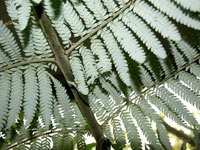
[Above] Ponga (underside of frond) -
Alsophila tricolor ,
a.k.a. Cyathea dealbata.
(See news for Jan-Mar 2023)
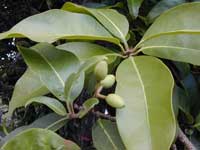
[Above] 'olopua (with fruit) -
Nestegis sandwicensis ,
Photo: (c) Forest & Kim Starr.
(See news for April 2022)
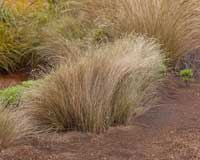
[Above] Wī -
Poa cita ,
Photo: (c) Mike Thorsen.
(See news for April 2022)
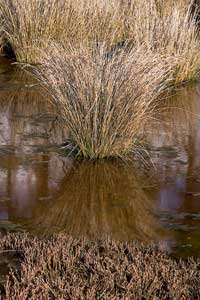
[Above] Wīwī -
Juncus kraussii australiensis ,
Photo: (c) Jeremy Rolfe.
(See news for April 2022)
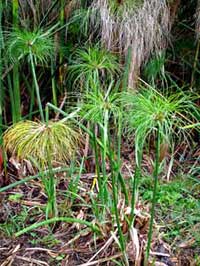
[Above] Kakaho (Biblical) -
Cyperus papyrus ,
Photo: (c) Peter de Lange.
(See news for April 2022)
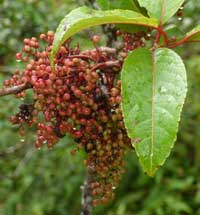
[Above] Olomea (fruit) -
Perottetia sandwicensis ,
Photo: (c) Forest & Kim Starr.
(See news for March 2022)
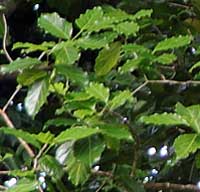
[Above] Oro'e'a (foliage) -
Cyclophyllum barbatum,
Photo: (c) Joseph Brider.
(See news for March 2022)
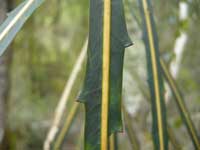
[Above] Horoeka (juvenile leaf) -
Pseudopanax crassifolius ,
Photo: John Sawyer (c) NZPCN.
(See news for March 2022)
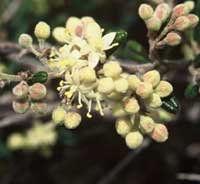
[Above] Tauhinu (flowers) -
Pommaderris phylicifolia,
Photo: (c) Gillian Crowcroft, NZPCN.
(See news for March 2022)
 [Above] The late Dr PaoraMato -
[Above] The late Dr PaoraMato -
Good friend of Te Māra Reo,
Photo: ResearchGate.)
d. June 2021. R.I.P.
(See news for October 2020-
February 2022)
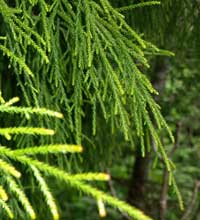
[Above] Rimu (foliage) -
Dacrydium compressinum ,
Te Māra Reo, Aotearoa.
(See news for October 2020 -
February 2022)
<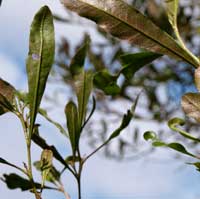
[Above] Ake, Akeake -
Dodonaea viscosa, Akeake
Te Māra Reo, Aotearoa.
(See news for Ocrober 2020 -
February 2022)
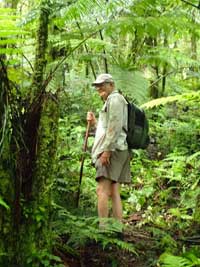
[Above] The late Dr Art Whistler, R.I.P.,
(Photo: NTBG, Kauai, Hawai'i)
(See news for July-Sept. 2020)
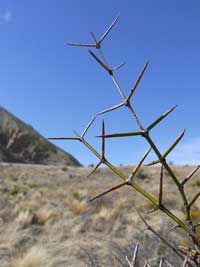
[Above] Tūmatakuru-
Discaria toumatou,
Aotearoa.
(Photo: (c) Jane Gosden)
(See news for July-Sept. 2020)

[Above] He otaota nō tawhiti ,
Aotearoa.
(See news for July-Sept. 2020)
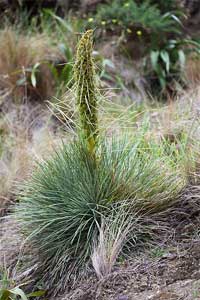
[Above] Taramea-
Aciphylla squarrosa ,
Aotearoa.
(Photo: (c) Mike Thorsen.)
(See news for July-Sept. 2020)
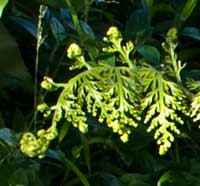
[Above] Mauku -
Asplenium bulbiferum,
Te Māra Reo, Aotearoa.
(See news for July-Sept. 2020)
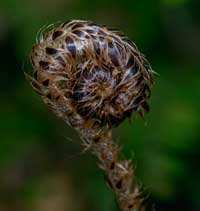
[Above] Pikopiko - Polystichium neozelandicum s. zerophyllum
Aotearoa. (Photo: (c) J. Rolfe)
(See news for July-Sept. 2020)
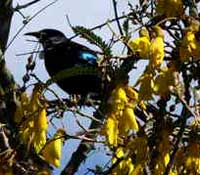
[Above] Kōwhai (& tūī)-
Sophora tetraptera
Aotearoa.
(See news for April-May and July-Sept. 2020)
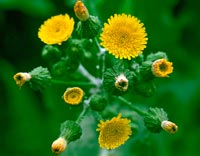
[Above] Pūhā, pūwhā, Sonchus kirkii,
Aotearoa.
(See news for March 2020)
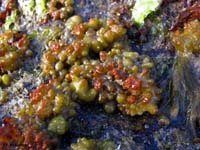
[Above] Pūhā, Colpomenia sinuosa,
Hawaii
(See news for March 2020)
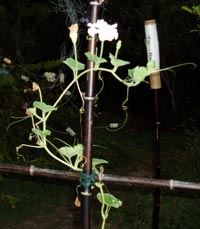
[Above] Hue, Lagenaria sicareria,
Te Māra Reo.
(See news for March 2020)
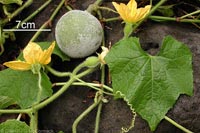
[Above] Hue 'aroro, Benincara hispida ,
Tahiti.
(See news for March 2020)
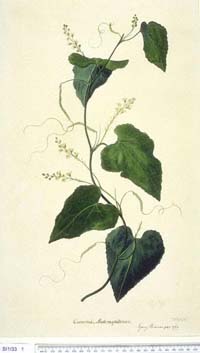
[Above] Huehue, Zehaneria grayana ,
Tahiti (1769).
(See news for March 2020)
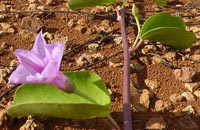
[Above] Hue, Lagenaria sicareria,
Te Māra Reo.
(See news for March 2020)
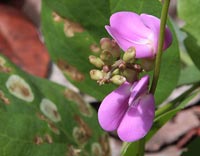
[Above] Pōhuehue, Canavalia rosea,
Hawaii.
(See news for March 2020)
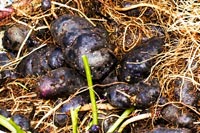
[Above] Tūtae kurī, Solanum tuberosum
heritage cultivar, Aotearoa
(See news for March 2020 [1])
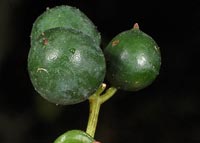
[Above] Zehneria mucronata ,
Tūtae fatitiri (?), Tuamotus.
(See news for March 2020 [2])
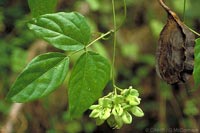
[Above] Tūtae pua'a, Mucuna gigantea,
Tahiti.
(See news for March 2020 [3])
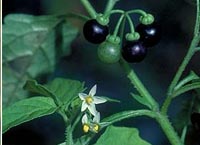
[Above] Solanum americanum ,
Tūtae puaka, Mangareva.
(See news for March 2020 [4])
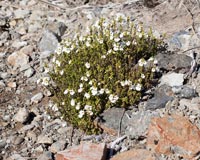
[Above] Euphrasia cuneata ,
Tūtae kiore, Aotearoa.
(See news for March 2020 [5])
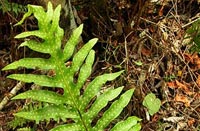
[Above] Microsorium grossum,
Tūtae puaka, Rarotonga.
(See news for March 2020 [6])
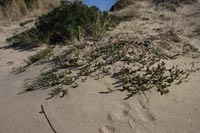
[Above] Pimelia lyallii,
Tūtae kōau, Aotearoa.
(See news for March 2020 [7])
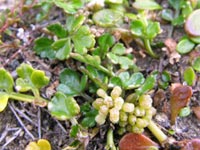
[Above] Apium prostratum v. filiforme,
Tūtae kōau, Aotearoa.
(See news for March 2020 [8])
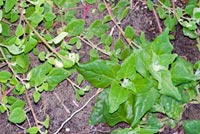
[Above] Tetragonia tetragonioides,
Tūtae
Ika Moana, Aotearoa.
(See news for March 2020 [9])
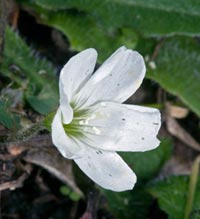
[Above] Oxalis magellanica,
Tūtae kākā, tūtae kāhu.Aotearoa
(See news for March 2020 [10])
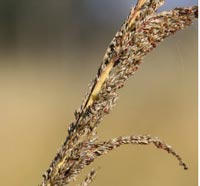
[Above] Sporobolus fertilis,
Tūtae kurī , Rarotonga.
(See news for March 2020 [11])
Harry-Rose.jpg)
[Above] Anthosachne kingiana v. multiflora ,
Tūtae kurī, Aotearoa
(See news for March 2020 [12])
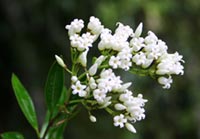
[Above] Parsonsia heterophylla,
Tūtae kereru, Aotearoa.
(See news for March 2020 [13])
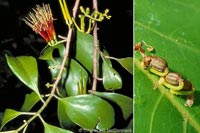
[Above] Decaisnina forsteriana,
Tūtae 'u'upā, Tahiti.
(See news for March 2020 [14})
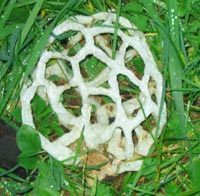
[Above] Ileidictyon cibarium,
Tūtae
whatitiri, tūtae whetū,
Tūtae kehua, Aotearoa.
(See news for March 2020 [15])
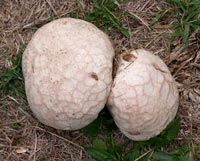
[Above] Lycoperdon sp. ,
Tūtae atua, Aotearoa.
(See news for March 2020 [16])
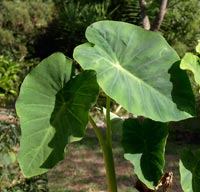
[Above] Cypriot Taro, Te Māra Reo.
(See news for January / February 2020)
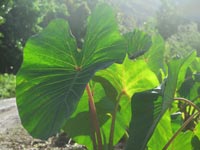
[Above] Taro, Rarotonga.
Photograph by Rovert Vennell
(See news for November / December 2019)
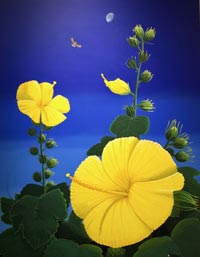
[Above] "Flower Power for Hawai'i Nei".
Painting by Ken Charon
(See news for November / December 2019)

[Above] Huhu beetle, sign of summer.
(See news for November / December 2019)
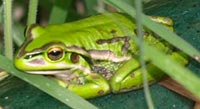
[Above] First frog seen in the garden, 2019
(See news for October 2019)
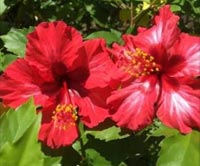
[Above] 'Aute Sāmoa (Hibiscus Rosa-sinensis) - another Polynesian "Canoe Plant"
(See news for October 2019)
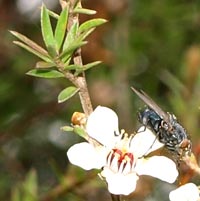
[Above] Kahikatoa / Mānuka (Leptospermum scoparium) - What's in a name?
(See news for October 2019)
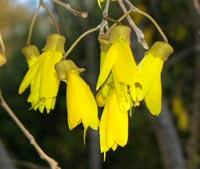
[Above] Kōwhai (Sophora tetraptera )
(See news for October 2019)
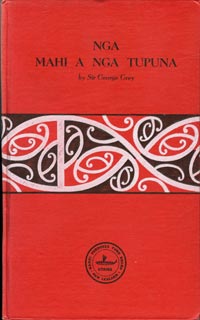
[Above] Sir George Grey's
Ngā Mahi ā ngā Tūpuna, first published 1854, the source for the story of Māui and the manapau
(see News for September 2019)
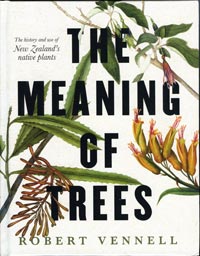
[Above] Cover of Robert Vennell's recently launched book The Meaning of Trees.
(see News for September 2019)
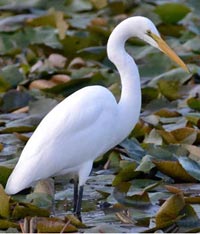
[Above] The Kōtuku, Egretta alba. This bird has inspired the naming of a Rarotongan tree, a fern in Aotearoa, and possibly other plants as well.
(see News for July-August 2019)
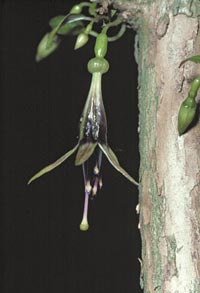
[Above] The Kōtukutuku, Fuchsia excorticata. This tree has many associates, possibly including the Great White Heron, and certainly several local trees and possibly some tropical Polynesian plants.
(see News for July-August 2019)
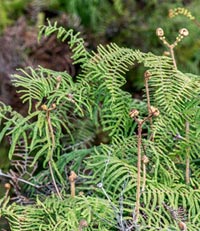
[Above] The Waewae-Kōtuku, "Umbrella fern", Gliechenia microphylla. The Māori name (one of several for this fern) likens its fronds to the feet of the kōtuku.
(see News for July-August 2019)
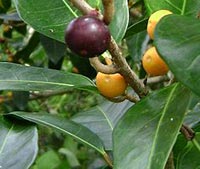
[Above] The fruit of the Mati, "Dyers Fig", Ficus tinctoria. This name is used to denote the domestic fig, F. carica, in Samoan Biblical translations, and the name has been inherited in Māori to denote the fruit of the kōtukutuku.
(see News for July-August 2019)
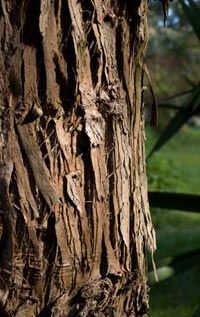
[Above] The trunk of the Tōtara, Podocarpus totara. The shredded appearance of the bark of this and some other trees links them to the kōtukutuku.
(see News for July-August 2019)
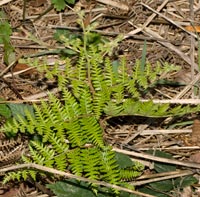
[Above] The pananehu, the young frond of the Rau-aruhe, Pteridium esculentum. Because of their similarity in habit and appearance, the Waewae-kōtuku (Gleichenia microplylla) is also known as Matua-rauaruhe, "first rauaruhe", or "parent of the rauaruhe".
(see News for July-August 2019)
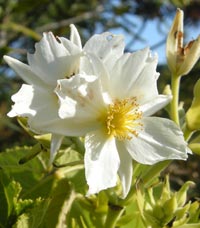
[Above] Flower of the Whau, Entelea arborescens. The light bouyant wood was ideal for canoe floats
(see News for March-June 2019)
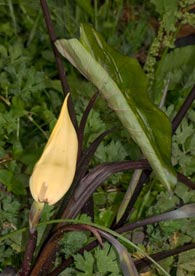
[Above] Flower of an ornamental variety of Taro, Colocasia esculenta, (Araceae), in bloom at the Landsendt Garden, Oratia, Auckland.
(see News for January-February 2019)
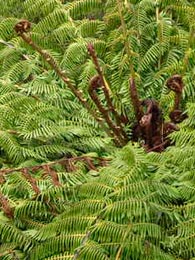
[Above] Crown of the Ponga, Cyathea dealbata (Cyatheaceae), showing emerging fronds.
(see News for October-December 2018)
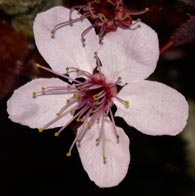
[Above] Flower of the Mānuka, Leptospermum scopariun v. scoparium (Myrtaceae). The nectar from these blossoms is the base of the most expensive honey in the world, sought after for its therapeutic as well as culinary properties.
(see News for September 2018)
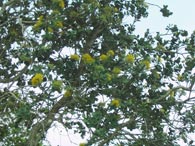
[Above] Ohia lehua, Metrosideros polymorpha, a close relative of the pohutukawa, in bloom, Amy Greenwell Ethnobotanical Garden, Hawaii, July 2010
(see News for August 2018)
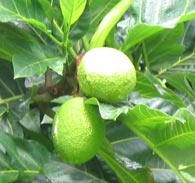
[Above] 'Ulu, PPN *Kulu, Breadfruit, Honolulu, July 2007
(see News for August 2018)
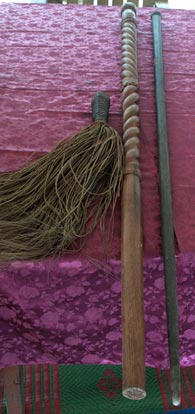
[Above] Orator's staffs and ceremonial fly whisk made from the wood of the pau tree (Manilkara Samoensis)
(see News for August 2018)
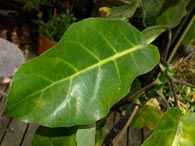
[Above] Leaf of the puka
Meryta sinclairii
(see News for August 2018)
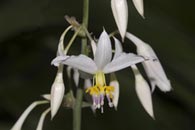
[Above] Flower of the rengarenga
Arthropodium cirrhatum
(Photo (c) Jeremy Rolfe, NZPCN)
(see News for August 2018)
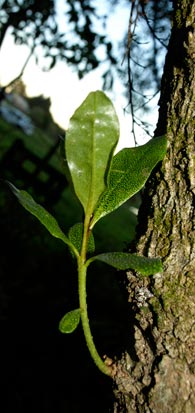
[Above]
Shoot emerging from the trunk of a Ngaio (Myoporum laetum)
(see News for June/July 2018)
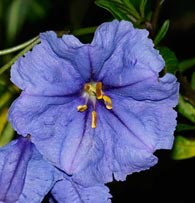
[Above] Flower of the poroporo
(Solanum laciniatum), Te Māra Reo
[See news of June/July 2018]

[Above]
Shedded skeleton leaf of a māhoe (Dysoxylum spectabile)
Photo (c) J. Rolfe (NZPCN)
(see News for May 2018)
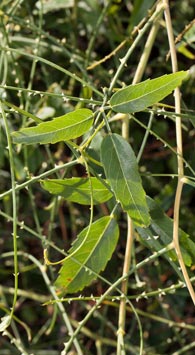
[Above]
Tātaraamoa (Rubus squarrosus)
Photo (c) Mike Thorsen, NZPCN
(see News for April 2018)
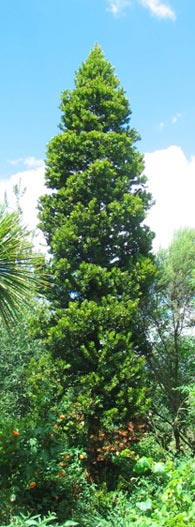
[Above] Kauri, Agathis australis,
Te Māra Reo
(see News for March 2018)
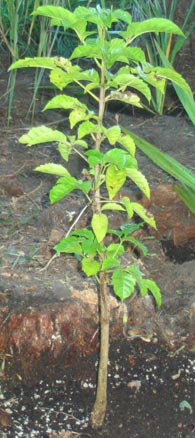
[Above] Newly planted puriri
(Vitex lucens) sapling
(see News for February 2018)
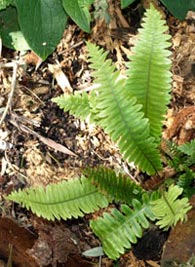
[Above] Lomaria discolor (formerly Blechnum discolor), Piupiu
(see News for February 2018)
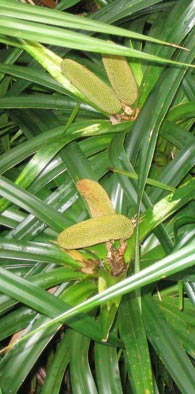
[Above] Fruiting stalks of the i'e'ie
(Proto Nuclear Polynesian *Kiekie),
Freycinetia arborea
(see News for January 2018)
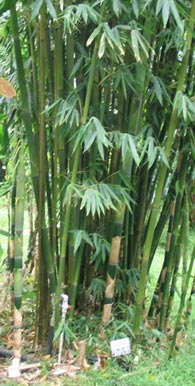
[Above]
'ohe, Schyzostachium glaucifolium,
PPN *Kofe
(see News for December 2017)
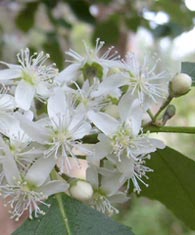
[Above] Houhere, Hoheria populnea
(see News for February 2016)
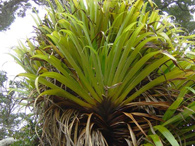
[Above] Astelia haastatum, Wharawhara (Photo:Wayne Bennett)
(see News for December 2015)
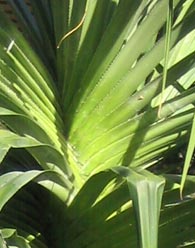
[Above] Base of Lauhala, Pandanus tectorius PPN *fara (Honolulu, 2007)
(see News for December 2015)

[Above] Orator's ceremonial fly whisk, with handle made from the wood of the pau tree (Manilkara samoaensis), Neiafu Tai Village, Savai'i, Samoa, July 2015 (see News for March/April 2015)
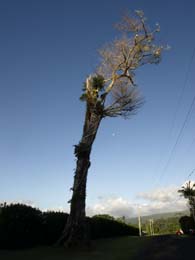
[Above] Ancient Mālili tree, Tiapapata, Samoa (See News, April 2014)
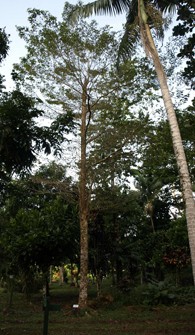
[Above] Mālili tree, Botanical Garden of Samoa, Tiapapata, Samoa
(Coconut tree in right foreground)
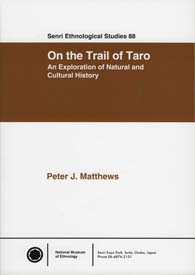
[Above] Cover of Peter Matthews' new book On the Trail of Taro
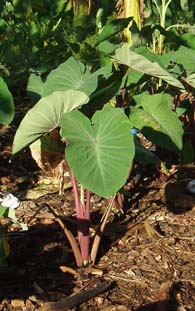
[Above] Cultivated taro, Vailele, Samoa
[See News, August 2014]
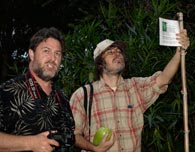
[Above] Prof Will McClatchey, Research Director, Botanical Institute of Texas, & Dr Peter Matthews, Osaka Museum of Natural History, examining one of the information "flags", 26 April 2012.
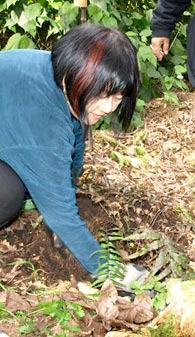
[Above] Ms Seiko Furuhashi, Osaka Gakuin University, planting a fern (piupiu, Blechnum novaezelandiae), 25 August 2011.
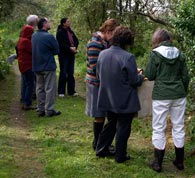
[[Above] Participants in the planning seminar examining plants of interest, 15 June 2011.
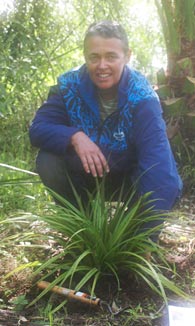
[Above] Shelley Arlidge, Director of the Russell Museum, planting an Astelia in the *Fala garden, 9 May 2011.
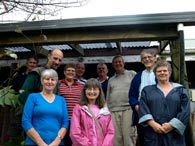
[Above] Members of the Waikato Branch of th NZ Tree Crops Association on their field trip to Te Māra Reo, 16 April 2011.
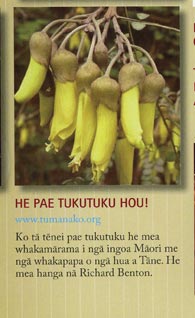
[Above] Item about Te Mara Reo web site in He Muka, Māori Language Commission newsletter, after visit to the garden by Drs Jeremy Evas and Te Taka Keegan, 6th February 2011.
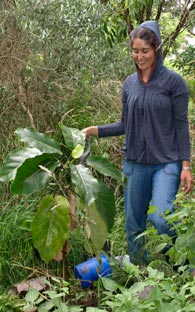
[Above] Mari Stock planting a puka
(Meryta sinclairi)
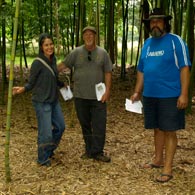
[Above] Grover and Mari Stock, permiculturalists from California, visiting the garden with Wikuki Kingi Jr, 25 January 2011.
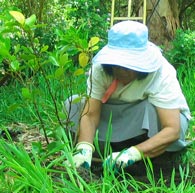
[Above] Medina Pawley planting a kāpuka, Griselina littoralis, 10 November 2010.
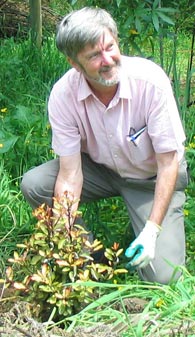
Above] Prof Andrew Pawley, Australian National University, planting a horipito, 10 November 2010.
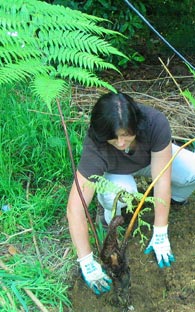
[Above] Dr Martina Buckova, Slovak Academy of Sciences, planting a mamaku (Cyathea medullaris) 10 November 2010.
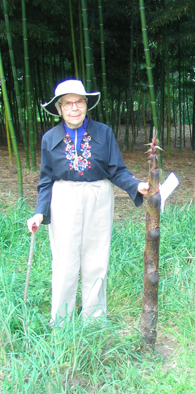
[Above] Prof Courtney Cazden, Harvard University, inspecting a new shoot of moso bamboo, 7 November 2010.
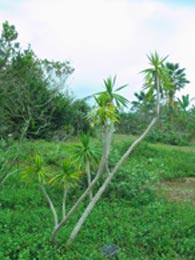
[Above] Hala pepe, Pleomele hawaiiensis, Amy Greenwell Ethnobotanical Garden, Hawaii,
July 2010
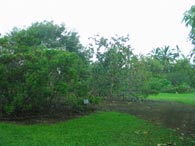
[Above] Open space with lawn bordered by trees, Amy Greenwell Ethnobotanical Garden, Hawaii, July 2010
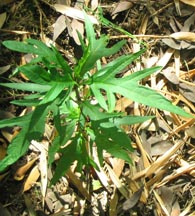
[Above] A poroporo seedling among the leaf litter at the edge of the moso bamboo grove.

[Above] A poroporo flower.
|
Ngā Rongo o te Wā ~
Notes and News
Introductory Note
This is where we note briefly significant additions, alterations and developments, both to this web site and to the garden itself, and occasionally miscellaneous items of interest. These updates are organized with the most recent at the top of the page, so that a bottom-up history of the project is starting to accumulate, which you can read backwards if you start at the top. The latest news to be made available on the site is right below this paragraph. If you want to skip the latest news and go to the short cuts to other recent items (from August 2018) click here, or to archived items (prior to August 2018), click here. Photographs related to each item from the current news back to November 2010 are arranged sequentially on the left-hand panel. More news is included in the occasional Friends Newsletter; links to back issues are in the Friends section of the "Arohaina mai/How you can help" page.
MOST RECENT BULLETIN!
July - October 2024
Two new substantial pages have been added. The first of these is a combined page for the mysterious Proto-Polynesian (or Proto-Solomon Outlier / East Polynesian) *Pakilangi, possibly originally Intsia bijuga, and migrating into South Island Māori as Pakiraki (and Pakirangi in the North Island, if it ever reached there), and, in an attempt to explain this phenomenon, an account of the spread of Austronesian languages from Taiwan to the Pacific, and the possible origin of the Eastern Polynesian languages (including Māori) in a mother language which developed in and around the atoll of Ontong Java in the Solomon Islands archipelago towards the end of the last millennium. The other page deals with the Proto-Polynesian word *Tawahi, which as Tavahi in Tonga, Tavai in Samoa and Āvai in Tahiti refers to the forest tree Rhus taitensis, and in Aotearoa (as Tawai or Tawhai) became the name for the southern beeches, Lophozonia menziesii and the four Fuscospora species.There are accounts of the trees, and the creatures that provide the honeydew for which, among other things, the New Zealand species are famous. The bibliography has also been updated.
April / May / June 2024
Mānawatia a Matariki!
One new page has been added -- a combined page for Proto-Polynesian *Nonu, Morinda citrifolia, and Māori Nonokia and Nonorangi (also known as Tainui), Pomaderris apetala. The page for Proto-Polynesian *Kofe has also been updated, with an extra photograph added for good measure. The delay in producing new pages has been the result of simply having too much else to do at that time of the year, both domestically and externally. The new government's attitude to te reo Māori has been a worry, and I gave that some attention on May 1 in a talk at an event sponsored by NZCER. It was mentioned in the evidence presented in support of the Ngai Terangi Claim in mid-June, and is available on the NZCER website. The Crown evidence relating to the Claim was interesting and raised the question of when is a proposed and agreed on policy a policy?: the Coalition agreement committed the government to restricting the use of the Māori language within and by government agencies, and some Chief Executives anticipated formal directives to this end and started implementing the policy agreed to by the governing coalition before they had been formally ordered to do so by their Minister or the State Services Commission (the latter, at the time of the hearing, had not yet given any directions in this regard) -- is this action by the Crown, or simply an "operational decision" by the Chief Executive anticipating a policy which is not yet actually a policy? The Waitangi Tribunal's findings will make interesting reading, as will the Government's response.
February / March 2024
Ngā tūmanako pai mō te Wā Whakamahara o te Aranga o Te Ariki ki a koutou katoa.
No new pages have been added since January, but the page for Kahikātoa / Mānuka (the plants) has been extensively revised in the light of recent research, with consequential updates to the pages for Mānuka (the name) and Proto-Polynesian *Nukanuka (its antecedent). New references, including those related to the genetic relationships of New Zealand variations of mānuka and descriptions of the newly defined species, have been added to the bibliography. The introductory pages to the website and the garden have also been updated.
January 2024
Three new pages have been added to welcome the New Year, and an addition to an existing page in lieu of another new one -- Proto-Polynesian *Tutu, Colubrina asiatica, and its companions Māori Tutu, Coriaria arborea and relatives, along with Proto-Polynesian *Tewe (teve in most contemporary Polynesian languages), and Māori Tewe, the latter incorporated in the page for Māori tutu. The pages on Māori tutu and Polynesian teve deal with noteworthy poisonous plants, and the page on teve has notes and quotations from Tahiian texts about the role of that plant in supporting the sky.
December 2023
Ngā mihi o te Wā Whānau o Te Karaiti me ngā tūmanako pai mō te Tau Hou ki a koutou katoa.
As well as the karaka (now bearing bunches of dark-green fruit ready for ripening when the sun reappears), tītoki, horoeka, māhoe, putaputawētā and many other trees and plants are fruiting or flowering now, a reminder that (as the National Tropical Botanical Garden in Kauai, Hawai'i points out in a note just received):
Plants make life possible. That isn't just a fact. It's an invitation. Plants are a pivotal part of the answer to climate change, biodiversity loss, food insecurity, and so many other issues we face today.
Again, only one new page this month, but it's quite a page, covering 31 names containing reflexes of Proto-Polynesian *tūtae (if you count cognate duplicates referring to different plants separately) distributed among a similar number of species -- or many more if you count mushrooms and fungi (which technically are not plants), in six island groups. There will still be more to come, but they can be added and commented on as they are found. This new page updates and greatly expands the list that was included in Ngā Rongo for March 2020. Two more "original" pages (for Proto-Polynesian *Kisi-kisi and Māori Kōkihi) were partly revised and updated while being transferred to the current format.
November 2023
Only one new page this month, Proto-Polynesian *Pele along with its counterpart Māori Pere, but during the month 19 of the original web pages have been transferred from the old 2009/10 format to the current one. These will now also be included in Google Analytics, so we will know more about whether and how often they are being consulted. Most are transferred with only minor revisions -- I have decided for the moment to concentrate on completely new pages when struggles against the bamboo and other diversions permit, and leave most of the updating and augmenting until later.
October 2023
This year the karaka have decided that it's a good idea to start fruiting again (last year none of our karaka bore fruit, and apparently it was a rather lean year in that regard throughout this part of the Waikato). Other native trees are following suit, and of course the moso bamboo is trying to make a comeback despite our efforts to dampen its enthusiasm.
One new page has been completed, covering Proto-Polynesian *Masele and Māori Māereere. We do not know what specific plants two of the apparent reflexes of the proto-Polynesian word refer to: Luangiua (Ontong Java) maele and Māori māereere, as they are glossed simply as "a fern". Since the other reflexes all refer to sharp-leaved sedges and contain the element "sele" or "hele" from the Proto-Polynesian word for "cut", it is likely that they have a separate origin.
The words relating to ferns perhaps date from a later time when the languages of East Polynesia and the Solomon Islands outliers were undergoing a common development. Because we don't know what particular plants were involved, we have chosen two especially interesting plants that grow both in Aotearoa and on Luangiua atoll -- the fern Cyclosorus interruptus and the unique ancient fern ally Psilotum nudum, neither of which has a contemporary Māori name, to stand in for a hypothetical proto-form,*maele.
July / August / September 2023
The answer to many of today's existential challenges lies in our relationship with plants. Climate change, global hunger, biodiversity loss. You name it, and plants are part of the solution.
These opening sentences from the (U.S.) National Tropical Botanical Gardens 2022 Impact Report, just received, seemed a very appropriate way to start this quarter's report. The plants have a lot of great importance to tell us, but are those who most need to listening?
We have completed the revision of the tree fern pages with some additional attention to that for Proto-Eastern Polynesian *Feki, a most perplexing word. Eight other new pages have also been added: Proto-Polynesian *Kalo, *Puka, and *Pilita, combined pages for Proto-Polynesian *Ngēngē and Māori Ngenge, PPN *Maafaqi and Māori Māwhai, and PPN *Mangeho and Māori Mangeao, along with pages for Māori Karo, Puka, Kāpuka, and Pirita. Minor revisions and updates have been made to many other pages. The fourth Friends' Newsletter, Te Māra Reo Kawerongo #4, was also sent out in time for Matariki.
April / May / June 2023
One completely new page has been added, for the birdcatching trees Ceodes brusoniana (Parapara in Aotearoa, Pāpala in Hawai'i) and Ceodes umbellifera (Parapara in Rarotonga, Pāpala in Hawai'i), along with two de facto new pages (replacing minimally informative shell pages previously noted at the bottom of the main list), devoted to Proto-Polynesian *Puka-tea, Pisonia grandis, another birdcatching tree, and Maori Pukatea, the forest tree Laurelia novae-zelandiae and a few other plants, respectively. Other defacto new pages have resulted from extensive revisions of the pages for Proto-Polynesian *Pala (denoting several species of fern and some root crops) and Māori Para, the fern Ptisana salicifolia and, also, some edible roots, along with that for whauwhau combined with (a different) parapara, names shared by Pseudopanax arboreus (a.k.a. whauwhaupaku, i.a.) and P. lessonii (a.k.a. houpara). Meanwhile, bamboo harvested from Te Māra Reo has provided the material for rafts to contain floating shoreline gardens as part of wetland restoration projects in Te Kauwhata and Whakatāne. More about that in the next Kawerongo.
January / March 2023
Two new pages have been added, and nine pages have been extensively revised and updated, in most cases being transferred from the old to the new format, so far this year. Many of these have been concerned with tree ferns, but the new pages feature the tree names Māori Tītoki and Proto-Polynesian *Taputoki (both long overdue for attention!). The changes to fern names mentioned in the last bulletin have been incorporated in the revised pages mentioned in the October/December bulletin, and in updated and extensively revised pages for: *Ponga; Ponga; *Mamaku; and Mamaku. It should be noted however that these changes are regarded as unnecessary in the checklist of ferns and lycophytes published recently by Manaaki Whenua / Landcare Research, which also disregards the revisions of the genus Blechnum, mentioned in the bulletin for February 2018, and incorporated in the pages for Te Māra Reo. The pages for the tree names *Kalaka; Karaka; Karakariki; *Kōpī / Kōpī, and Ramarama / Horopito have also been extensively revised. Kawerongo #2 and #3 are both now available on line. As always, further work is underway, as time and resources permit!
Te Tau o te Rāpeti ~ The Year of the Rabbit
The rabbits of Chinese mythology are essentially benign creatures, noted for their quick wits, quirkish sense of humour, agility, and resourcefulness. Farmers in Southland, and maintainers of gardens elsewhere, view then in a different light. We hope that 2023 will bring peace, tranquility, prosperity and, in this part of the world, at least, fewer rabbits!
Kawerongo #2 is now available on line, and the third newsletter has been distributed to our Friends group. It will appear on line when they have had time to digest its contents. The question it raises about the naming of New Zealand's scaly tree ferns, the whānau of Te Hāpuku, has now been answered with the changes to the botanical names made on the NZPCN web site a day or two after the newsletter appeared.
Cyathea medullaris (māmaku) is now Sphaeropteris medullaris;
Cyathea dealbata (ponga) is now Alsophila tricolor;
Cyathea smithii (katote) is now Alsophila smithii.
The remaining New Zealand species formerly grouped under Cyathea are also now placed under Alsophila, retaining their specific names. The naturalized former Cyathea cooperi, an Australian species found in Auckland , is now Sphaeropteris cooperi.
The reasons for these changes will be noted briefly on the relevant web pages, and discussed in more detail in the next Friends' Newsletter. The following changes will also be made to the names of tropical Pacific tree ferns included in our web pages:
Cyathea parksiae becomes Sphaeropteris parksiae;
Cyathea decurrens becomes Alsophila decurrens;
Cyathea affinis becomes Alsophila tahitiensis;
Cyathea truncata (a.k.a. Alsophila truncata) becomes Sphaeropteris truncata.
Note also that:
Angiopteris commutata is now Angiopteris evecta;
Alsophila rugosula is now Sphaeropteris lunulata.
The last two changes were made some years ago but the older names still appear in some publications.
October / December 2022
No new pages have been added, but four pages have been extensively revised and updated, in most cases being transferred from the old to the new format. These are all concerned with tree ferns, but the page for *Feki also includes bananas: *Feki; Whekī; Whekī-Ponga; *Fāpuku / Hāpuku. There is also a good chance that Te Māra Reo Kawerongo #3 might appear before the New Year, and issue #2 consequently be available via the website.
August/September 2022
The revision and updating of especially significant older pages has continued, with five more completed: those for *Milo (Polynesian), *Toromiro (combined Polynesian and Māori), Miro, Rewarewa, and *Palatao (combined Polynesian and Māori). We were able to incorporate in the new page for Rewarewa (Knightia excelsa) some photographs taken in Te Māra Reo of the interesting way the Rewarewa flowers develop, as flower buds started forming on our tree for the first time while the page was being written. Additions have also been made to the bibliography. Winter has gone (officially at least) and Spring is now a month old, yet the latest newsletter is still under development. A project using storytelling as a way for young children to go from listening and speaking to writing and reading in te reo Māori has taken precedence, but Kawerongo #3 has not been forgotten.
June/July 2022
Work has progressed on revising some key existing pages, most of which were among those prepared for the embryonic and infant website in 2008-9. They are now in the newer format, and have a substantial amount of added information, along with many more illustrations. We are now about half way through this particular project, although there will still be quite a number of older pages to re-format along with new pages to add ā te wā . Over the last six weeks these pages have been extensively revised, updated and reformatted: *Tii, (Cordyline frutescens); *Toa, (Casuarina equisetifolia); Toatoa, (Phyllocladus trichomanoides &c.), *Toi,(Alphitonia zizypphoides); Tōī,(Cordyline indivisa); *Futu, (Barringtonia asiatica); Hutu, (Ascarina lucida &c.); *Pofutukava, (Sophora tomentosa &c.); Pōhutukawa, (Metrosideros excelsa); and *Naupata, (Scaevola spp.).
May 2022
There are some more substantial additions to report this month. New pages have been added for *Kiwa/Kiwakiwa, *Pua/Puapua and the semantically related Puāwai (which includes the Biblical uses of the Māori terms), and Manoao, a tree name unique to Aotearoa, but also used in Biblical contexts, and particularly interesting because of the way English and Samoan have been used to translate the Hebrew terms in the same texts. Additional information has been added to the page for *kakaso/kakaho; the page for kawariki has been updated and shifted to the new (post 2014) fomat. The page for tī has been extensively revised and expanded, and the format updated. Information about a new species of Leptospermum (L. repo) has been added to the page for Kahikātoa/Mānuka. A few small amendments have also been made to the summary page for the word mānuka in the light of this development. Over the next few months an effort will be made to update and reformat more of the pages that were first written in 2009 and have not yet been shifted to the new format (and, among other things, are not included in the Google Analytics reports). So there will probably be new information but few completely new entries for a while.
April 2022
There are some substantial additions to report this month. New pages have been added for *Kolopua/Koropuka (which includes an interesting moral tale from the island of Rennell) and Wī/Wīwī, and the section of the "Genealogy of Language" page dealing with the "Nuclear Polynesian" to Eastern Polynesian phase of the migration to Aotearoa has been revised in the light of new genetic and archaeological evidence, with a consequential note added to the page on kumara. The use of the plant names wiwi and kakaho in Te Paipera Tapu has been included on those pages, with cross-references to others. More references have also been added to the bibliography.
It may be noted that wīwī is a home-grown word, not one brought from Polynesia. However it is one of the Māori words included as a plant name in Te Paipera Tapu, which justifies its inclusion in these pages!
March 2022
Kua oho te taniwha! This has been a very productive month for the website. A new Friends Newsletter has been produced, after a much longer gap than originally planned, so the first one is now available on line. New pages have been added for tauhinu/*tausinu and horoeka/*soroeka. The pages for *mako and makomako have been extensively revised, those for *piu and piupiu have been converted from the old format to the new, revised and updated, and Biblical references have been added to the page for raupo. They had already been added to the page for nikau, but this had not been noted in the index -- it has now, and some additional material has been added to the page. Further work is actively under way.
October 2020 to February 2022
We were greatly saddened to learn early in June last year that our very good friend Paora Mato had died suddenly. This came as a great shock, as we thought Paora was in the best of health and we were looking forward to seeing him again in the very near future. He was not only a good friend who had given us great deal of practical help with our garden, but I also had the privilege of being a co-supervisor for his PhD in Computer Science, which he completed in 2018, advising him on the linguistic aspects of his studies. Kia whiti ki a ia te māramatanga mutunga kore.
The long gap between news bulletins is not quite a record -- that belongs to the space between February 2016 and December 2017, but that is little consolation. The extended interlude stems partly from my ignoring advice not to plant moso bamboo (Phylostachys edulis) 24 years ago. Other things have also intervened, including editing and contributing to a book on Māori governance involving multiple authors (now published) and a number of other projects. However, in recent months progress at last is is discernible towards the liberation of the physical garden from the invasive moso, and the virtual garden -- this website -- is also being tended again.
Along with this bulletin six substantially revised pages have been added to the website -- for Rimu/*Limu (combining the previously separate pages), Ake/Akeake, *Ake *Kofe, Kohe/Kohekohe, and *Maota. Sections on the Biblical uses of these words have been added to the first two, and some extra material has been added to the section on the Biblical use of the Polynesian reflexes of *Maile in the page for Ramarama. The index page has been updated and more pages are in preparation.
Links to Recent News Bulletins (from August 2018)
April 2022
Two new pages, one with Biblical references (also added to another page). "Nuclear Polynesian to Eastern Polynesian" section of "Genealogy of Languages" page revised and expanded in the light of new evidence.
March 2022 Two new pages, Biblical references added to two others, and four other pages reformatted and extensively revised.
A new Friends Newsletter has been produced. October 2020-February 2022
Although there had been a long gap between bulletins, the main things to report were the untimely death of another dear friend and supporter of Te Māra Reo, Paora Mato, along with two time-consuming tasks -- the ongoing struggle against the moso bamboo, and organizing the completion of the book Waking the Taniwha on Maori governance -- and coping with a leg injury. The moso was still a problem, but coming more under control, and the latter problems have since been resolved (although the formal launch of the book has been delayed because of Covid and civil disturbance around Central Wellington. Ā te wā! However more new pages had been added, and major revisions made to others.
July-September 2020
This turned out to be the last bulletin for more than year!
It began with a tribute to our late and much-loved colleague Dr Art Whistler, an early victim of Covid-19. Four new pages were added, for tūmatakuru, otaota and associated words, including their Biblical connotations, mauku, and piripiri, and a small addition was reported for the page on kauri. The first issue of the "Friends" newsletter has been sent out, including news of the arrival in the garden of three kererū, the first time we have been visited by these magnificent birds.
April-June 2020
A quiet time, but the page for kōwhai has a small addition.
March 2020
A new page has been added for pūhā, and the pages for hue and its cognates have been extensively revised. Thanks are also given to a generous donor -- the first cash donation we've received for almost ten years, and a great help in keeping the website going. The section concludes with an extensive and illustrated review of the Māori plant names incorporating the word "tūtae", and a few of their Polynesian counterparts.
January/February 2020
More information about taro, and advice on cooking the Cypriot strain. Official reopening of the Amy Greenwell Ethnobotanical garden on the Big Island of Hawai'i.
November/December 2019
Updates to the taro page; a community trust established for the Amy Greenwell Ethnobotanical Garden; reappearance of the huhu beetle.
October 2019
Addition of new information about 'aute samoa and other Hibiscus species. The first frog of the season has arrived. Updates to the page on mānuka. Additions to the bibliography.
September 2019
The page for mānāpau
has been revised, and augmented by the Māori text of the story of Māui's association with this tree. The publication of Robert Vennell's book, The Meaning of Trees, is also noted. The Amy Greenwell Ethnobotanical Garden in Hawaii is closer to re-opening.
July-August 2019 -- New pages for *kōtuku, kōtukutuku and *mati, and updates to the pages on totara and rauaruhe.
Also some notes on efforts to restore the rich verdure and beautiful foliage to the banks of the Waikato River, after the depredations of the "men of the axe" who followed on from General Cameron and his troops after the British occupation of Ngāruawāhia in 1863.
March-June 2019 -- More added to the page on taro, and additions and revisions for the pages on whau and karakariki.
January-February 2019 -- Update to page on taro.
October-December 2018 -- "Kai without kai moana" - an update to the page on ponga.
September 2018
All about mānuka and mānuka honey!
August 2018
~
New and revised pages.
~ Retrospective -- Eleven Years On
~~ The Amy Greenwell Ethnobotanical Garden
~~
The Way Forward
~~
Gallery: The Amy Greenwell Ethnobotanical Garden, 2010
Haere anō ki ngā rongo o mua atu -- On to older bulletins.
July-September 2020
We note with great sadness the passing of our very good friend, the ethno-botanist and expert on plants of the Pacific, W. Arthur (Art) Whistler, one of the early victims of the Covid-19 Pandemic. There is an excellent tribute to Art on the University of Hawaii website. Another warm tribute is on the National Tropical Botanical Garden website, from where the photograph of Dr Whistler in Savai'i, Samoa, in the side panel, is taken. Requiescat in pace.
Four substantial new pages have been added to the web site. One is devoted to the formidable tūmatakuru (Discaria toumatou) and taramea (Aciphylla squarrosa), with their traditional and Biblical associations. Another looks at five plant-related terms: otaota (herbs), tarutaru (herbage, often referring to actual and metaphorical herbage of a less than desirable kind, like ngā tarutaru nō tawhiti ~ "weeds from afar", such as the Covid-19 Pandemic), rākau (trees, plants, and wood products), māhuri (saplings), and wahie (firewood), again with traditional and Biblical associations. A third page is devoted to the fern mauku (Asplenium bulbiferum, and also A. gracillimum) and the term pikopiko, which relates both to a particular fern (Polystichum neozelandicum s. zerophyllum), and the unfolding fronds which are a tasty ingredients in salads. The fourth page is devoted to the plant name piripiri, which is applied to a variety of plants which in some way cling -- through their scent or habit of growth. The page for Kauri has also been augmented with additional information about the links between the kauri and the tohoraha, the Southern Right Whale.
Another breakthrough has been made in the long-delayed production of a newsletter for people who have asked to be included as "friends of Te Māra Reo". It's taken more than ten years to produce the first edition, but I'm hoping that future issues will come out every three or four months -- not an impossible task as they can replace the extended bulletins which appear on this page from time to time. I will post the previous issue on the "Friends of Te Māra Reo" section of the "Help" page when a new issue has been circulated. The first issue notes the new pages mentioned above, the arrival of a trio of kererū as well as the usual kōwhai blossoms to herald the arrival of Spring, the pages viewed most often (some predictable and at least one real surprise), a section on the Māori plant names used in Te Paipera Tapu, thanks to all those who have helped with photographs to enliven the pages on this site.
April-June 2020
A reference to a paper on Kōwhau Ngutu Kākā (Clianthus spp.) has been added to the page on Kowhai, and a lot of other work has gone on in the background, which will be reported on in the next bulletin. Aroha mai!
March 2020
March has turned out to be a quiet month with a dramatic finale. We hope that friends of Te Māra Reo and other visitors to the web site, their families and associates are able to stay safe from the virus that is devastating so many families and communities. Our sympathy and concern goes out to all who have been affected by this scourge.
After an eight month interlude, a completely new page has been added to the site; it focuses on the Māori plant name pūhā (or pūwhā) and its Polynesian counterparts, including the use of the Māori plant name in Biblical translations.
The pages dealing with the Proto-Polynesian plant name *fue, and its reflexes in modern Polynesian languages have also had an extensive makeover, with a new page devoted to *fue and its direct descendants in Western Polynesian languages (referring principally to members of the convolvulus family and other vines and creepers found near the coast). Another new page combines two older ones devoted to the Eastern Polynesian word *hue and the plants its direct reflexes denote (principally the bottle gourd Lagenaria sicareria, but also other species of gourd) in Māori and other Eastern Polynesian languages. A section on the use of the Māori word in Biblical translations has also been included. A third page completed is a revision and updating of the page devoted to the related Eastern Polynesian word *pōhue, and its Island Polynesian reflexes (referring essentially to the same plants denoted by *fue and its descendants in Western Polynesia). The final step in this series will be a thorough revision of the current page dealing with the plants named with local reflexes of *pōhue. This is currently under way. These new pages are much more detailed, better illustrated, and (I hope) more interesting and informative than those they have replaced!
Minor corrections
have been made to quite a number of pages, but only two need to be mentioned here. Firstly the "how you can help" page, accessed through the "YOU CAN HELP! / Arohaina mai!" tab, has been revised after we received a generous koha from a visitor who wished to be enrolled as a "Friend". The cost of keeping the site on line is an ongoing and mounting expense, and any help we receive towards this is greatly appreciated. Our benefactor had asked me if we had a bank account for donations, and I was happy to be able to tell him that we did have an account exclusively for Te Māra Reo -- it was established in 2007 with funds sent to us by family and friends after Nena's death, and the most recent deposit was made in 2011 (that was the last time a monetary koha had been received)! The account is now healthy enough to pay our web-hosting fees, which I normally pay personally, for the rest of the year. I am very grateful to our recent benefactor, and have updated the web page in case others might like to contribute in this way.
The other page with significant additions and amendments was the historical linguistics overview, "A genealogy of Names" accessible via the "ORIGINS/Whakapapa" tab, and linked to some other pages. The "Proto Nuclear Polynesian" section of this page has been expanded to include the hypothesis advanced (with considerable linguistic evidence to support it) that instead of sailing directly from Samoa or thereabouts to East Polynesia, the ancestors of the East Polynesians spent a considerable amount of time in the atolls occupied by the "Polynesian Outlier" communities in Pohnpei and the Solomon Islands before leaving the Solomons to head in this direction via Tahiti. From the Solomons they would have retraced their 2-3,000 km outward route and sailed on another 2,500 km to East Polynesia. The case is not yet resolved, but an alternative explanation of the linguistic evidence is still required to disprove it.
As always in recent years, we are greatly indebted to the members of the NZ Plant Conservation Network who have made their photographs of native plants available for use to illustrate the pages on this site, to Gerald McCormack for allowing us to use his photographs of Cook Islands native flora, to Forest and Kim Starr for the use of their collection of photos of native and exotic plants growing in Hawaii (which include many from elsewhere in tropical Austronesia), friends of Te Māra reo who have sent us photographs from time to time, and to others who have made photographs available to the public domain or for non-commercial use through sites such as WikiMedia. We have also been able serendipitously to commemorate the 250th anniversary of the arrival of the Endeavour expedition in Polynesia with a reproduction of a drawing done in Tahiti by Sidney Parkinson in 1769. This was a picture of the vine Zahneria grayana, hue 'aroro in Tahiti, now in the collection of botanical drawings from the expedition in the Natural History Museum in London (shown also in the gallery on the left). Whatever one thinks of Captain Cook as a person or an agent of British imperialism, botanists owe him a great debt for facilitating the scientific investigation of the flora of the places he visited, and taking with him artists like Sidney Parkinson (1745-1771) to make superb visual records of the plants they observed. This was the best picture of the Zahneria that we could find.
Use of the word "tūtae" in plant names.
It is always good to get questions and observations from friends of Te Māra Reo and other visitors to the site -- these often speed up the production of new pages or additions and amendments to existing ones. The latest question concerned the use of the term tūtae in many Māori plant names, and whether this occured elsewhere in Polynesia. It came at a very opportune time, as I was trying to pinpoint the referent of the name tūtae fatitiri in the Tuamotus for an unnamed species of gourd.
This is defined, under a cross-reference from the entry for pōhue ("a variety of gourd-bearing creeper") in J. Frank Stimson and Donald Marshall's Dictionary of Some Tuamotuan Dialects of the Polynesian Language, as "the round berries of the pōhue plant; the kernels are used to prepare a medicine for swellings or nodules". My guess is that the gourd is either a species of Zehneria, which would fit the description in the Stimson and Marshall dictionary better, or else the wax gourd, Benincasa hispida. But I have found nothing about the "kernels" of either plant being used to treat "swellings and nodules", nor evidence of a species of Zehneria's being present in the Tuamotus. So the identity of this particular lightning deposit remains uncertain. (I am continuing enquiries.)
The question about the use of
the term tūtae in plant names generally can however be answered with more confidence. First it must be noted that in Polynesian languages this word does not have the primarily scatological connotations of its common English equivalents "turd" or "excrement". It could perhaps be more accurately defined as "deposit, often of fecal matter". It is quite a matter-of-fact word, so that few Māori-speakers would be put off eating a meal incorporating tūtae kurī, a delicious heritage variety of potato, just because its name translates as "dog turd" (probably bestowed because of the shape and general appearance of the tubers). Other names in this category (general appearance of part of the plant) are tūtae pua'a (pig ~, Tahiti) Mucuna gigantea "Sea bean";
tūtae kiore (rat or mouse ~) is the Mangarevan name for the small poroporo, Solanum americanum
(in Japan the berries of Privet have the an equivalent name). The Māori tūtae kiore, the tūtūmako or North Island Eyebright, Euphrasia cuneata, may owe this name to its small, oblong seed capsules.
Distribution or co-occurrence can also play a part. tūtae puaka (pig ~, Rarotonga)
Microsorium grossum, perhaps because of the way it's scattered around on old tree stumps in the forest;
tūtae kōau (shag ~, Māori) Pimelea lyalii, possibly referring to the way the tops of its branches look as if they have been scattered through the sand dunes by a passing sea-bird;
the other Māori tūtae kōau, Apium prostratum v. filiforme (NZ wild celery) probably owes its name to its distribition along lagoons and in other places frequented by shags (kōau, kāwau) and the appearance of its clusters of fruit.
Tūtae ika moana (fish-of-the-sea ~), Tetragona tetragonoides, kōkihi or NZ spinach, another denizen of the coastal fringe, may get its alternative name from its association with that habitat. The names tūtae kāhu (hawk ~) and tūtae kākā (parrot ~) associated with the forest-dwelling Oxalis magellanica are somewhat puzzling, but may reflect the forest habitats which both the plant and the birds frequent.
Sometimes smell may be a factor, in itself or combined with others: this may be the case for yet another kind of tūtae kiore (rat ~) in Mangareva,
where the name has also been bestowed on a species of Alyxia. This genus has several species noted for their pleasant fragrance, among them the maile of Hawai'i (Alyxia olivaeformis) and the maire of the Cook Islands (A. stellata). Perhaps the Mangarevan species has not so pleasant a scent: the entry in the Rensch & Whistler Dictionary includes the note "like the maile pilau of Hawai'i" -- plants of that species, Paederia foetida, are described in the Wagner et al. Manual as "twining, malodorous vines". On the other hand, in the absence of further information, it is possible that rather than the Alyxia's fragrance, the shape of the fruit, or its dispersal by means of rat droppings, may have merited the Mangarevan name.
More of a puzzle, for which I cannot yet suggest a possible solution, is the assignment of the name tūtae kurī (dog ~) to species of grass in both Rarotonga (where it is the name of the invasive exotic Giant Parramatta
Grass, Sporobolus fertilis) and in Aotearoa to the native wheat grass, Anthosachne kingiana subsp. multiflora. Another puzzle is why Parsonsia heterophylla, otherwise known as tatuauā, kaihua, akakaikiore and the NZ Jasmine, should also have the name tūtae kererū (pigeon ~). This vine which festoons trees in damp forest margins with tresses of its heavily scented flowers does not seem to have any obvious association with pigeons (its seeds are dispersed via tufts of hair, like thistles, rather than the succulent fruits which kererū feast on), unlike its near-namesake in Tahiti, the tūtae 'u'upā, Decaisnina forsteriana (also pigeon ~; in Māori kukupā is an alternative name for kererū). This hemi-parasitic vine is indeed a deposit from the dove: the berries are eaten by the 'u'upā, which then deposits the seeds with a dose of fertilizer to give them a good start in life on the trunks of suitable trees.
This brings us back to tūtae fatitiri, for which there is a plausible explanation, even though the identity of the Tuamotuan vine with that name may remain for the moment a mystery. A number of plants (or plant-related phenomena) which appear "out of the blue" or unexpectedly
are attributed to the actions of natural forces or invisible beings. Tūtae fatitiri belongs in this category; its counterpart in Māori is tūtae whatitiri (also lightning ~), the basket fungus Ileodictyon cibaruim. Its alternative names are tūtae whetū (star ~) and tūtae kēhua (goblin ~). Similarly the puff-ball fungi (Lycoperdon spp.) are tūtae atua (spirit-being ~).
Tūtae is a heritage word, ultimately from Proto-Austronesian
*Ca'i through Proto-Oceanic and Proto-Polynesian *ta'e, and Proto Eastern Polynesian *tūta'e, all including the core meaning of excrement, usually with the possibility of metaphorical extension in varying directions, including its use in plant names -- there are more such names in Eastern Polynesia in addition to those listed above. *Tūtae is one of the words which may provide evidence of a special link between Eastern Polynesian languages and those which are spoken in the Polynesian Outliers at the opposite side of the Polynesian Triangle, in the Solomon Islands and Micronesia, as it is reflected in the languages of Sikaiana, Kapingamarangi and Nukuoro, as well as most East Polynesian languages, but not in Samoan, Tuvalu, or Uvean.
The numbered illustrations in the left hand column relating to this section of the bulletin were taken by the following people: [1], [15] & [16], R.B., Te Māra Reo; [2] Pieter Pelser & Julie Barcelona; [3], [4], [6], [11] & [14], Gerald McCormack, CIBT; [5], [7] & [8], Mike Thorsen, NZPCN; [9] &[10] Jeremy Rolfe, NZPCN; [11] Queensland Dept. of Agriculture & Fisheries; [12] Harry Rose, Wikipedia; [13] Wayne Bennett, NZPCN.
January / February 2020
It has been a quiet start of the New Years (2020 & the Year of the Kiore) too.
Another paper on the early history of taro cultivation in New Zealand has been added to the bibliography: "Justin Maxwell & Karen Greig, Discussion paper on historic taro (Colocasia esculenta (L) Schott) in the Auckland Region", Report Series No. 202 prepared for Auckland Council Heritage Unit, December 2016. There are also papers on the introduction and cultivation of taro in the Mediterranean, which relate to Te Māra Reo through a plant of a Cypriot variety of taro (illustrated in the side panel) with a very interesting link to Te Ao Māori, given to us by Dr Peter Matthews. This is from the taro patch at Putiki Marae, Whanganui, thanks to the Greek Cypriot owner of "the best fish and chip shop in Whanganui", who presented it to the marae several decades ago. This Greek/Egyptian variety makes very good eating (the leaves apparently are not eaten), but it has a high content of Calcium oxalate crystals, which have to be removed by thorough boiling -- it is most conveniently treated like bamboo shoots, boiled for ten minutes or more first, then the water discarded and the corms cooked. Peter Matthews gave me this information and advice about it:
The Egyptian taro is remakable in producing a lot of acrid slime when cut corms are exposed to water.
In Egypt this is removed by repeated salting and washing of raw cut pieces. In water-poor Cyprus water is strictly avoided, and instead a dry cloth is used to wipe peeled corms clean. The slime remains in the corm and is cooked in situ, and lemon juice is added near the end of cooking to reduce any slime released: the acidity breaks down the slime, which is a complex mix of carbohydrates with nutritional value.
The Cypriot method seems best to me, from a nutrition perpective, but boiling and discarding of the first water is easiest - the third way.
There are also two more photographs in the gallery on the page for taro: one of a replanted
lo'i (taro wetland) in the pu'e pu'e (mounded) method at the Polynesian Cultural Center in Laie, Oahu, Hawai'i by our friend Lono Logan, and the other by Peter de Graaf, a reporter for the Northern Advocate, of the blessing of a pou at Mangahawea Bay, on Moturua Island, site of one of the earliest sites of Polynesian settlement in Aotearoa, while the waka hourua Haunui waits at anchor.
And finally, as a great ending to the month, the Amy Greenwell Ethnobotanical Garden in Kealakekua, Hawai'i was officialy re-opened to the public on February 29th with a major public event, the first in four years.
Hoki atu ki te rongo o te wā -- Back to current bulletin.
November / December 2019
It has been a quiet end to the year as far as Te Māra Reo is concerned, although weeds and the dreaded moso bamboo have been flourishing, along with the more esteemed plants. Work on an affidavit to support the Maori beekeepers' case against the appropriation of the word "mānuka" for Australian-produced tea-tree honey, along with the Māori governance book, got in the way of preparing any new pages. Two new references to papers about taro have been added to the bibliography, however, and also to the taro page: Peter Matthews' account of "Written records of Taro in the Eastern Mediterranean", which date back 2,000 years -- long after the plant was first cultivated in that part of the world, and a paper by Tetsuo Mikami and Sakio Tsutsui on taro cultivation in Japan, which has been on-going since taro arrived there about 1,000 BC. Taro is still widely cultivated in both regions, but the care needed to produce good crop is summed up in an Egyptian proverb quoted by Peter Matthews: "Everything comes by chance, save qolqas [taro], which requires tilling and watering".
Good news from Hawai'i
We were delighted to receive the news that after a worrying period of uncertainty, a community trust, the Friends of the Amy B. H. Greenwell Ethnobotanical Garden, has been able to purchase the Amy Greenwell Ethnobotanical Garden in Kealakekua, Hawai'i (see the account in the news for August 2018 for a description of the garden as it was in 2010). Here is the press release:
Overlooking Kealakekua Bay, this historic property includes five parcels of land and preserves accessible and well-explained archaeological features of the pre-Cook Kona Agricultural Field System. The ethnobotanical Garden contains three separate pieces consisting of Amy Greenwell’s former residence and garden, the nursery and garage piece, and the modern Visitor Center and parking lot site. Combined as one unit, these twelve acres are now under federal protection as a Community Forest, the first community forest ever designated in the Pacific Region by the USDA Forest Service. The purchase also includes Pa`ikapahu Heiau, located in a parcel in Kinue Terrace, and one vacant lot on Lilikoi Lane.
Thanks to her bequest to Bishop Museum by Kona resident Amy Beatrice Holdsworth. Greenwell, a fervent Museum supporter and expert in Hawaiian botany, the Museum began to establish a unique garden in the “pre-Cookian” style in the late 1970s to fulfill what Amy believed to be a critical mission: to perpetuate the plants and associated culture of old Hawai‘i. Renowned Bishop Museum anthropologists Douglas Yen, Yosihiko Sinoto, and Kenneth Emory honored the friendship they had forged with Amy over the years by taking a lead in the development of the Garden. This unique garden, which has hosted three generations of archaeological research, was designed in four biogeographical zones to feature Hawaiian and canoe plants, within a compact space of just under 12 acres.
Today, plants that thrive at sea level sprout in sandy beds at the Garden’s makai [seaward] boundary: palms, creeping morning glories, kou and milo trees, and clumps of pili grass. Meandering paths lead past dry land forest shrubs and through tidy agricultural plots of kalo [taro] and sweet potatoes, wauke [aute] and bananas. Towering breadfruit trees shade low stone walls built by Kona’s first gardeners, Polynesian pioneers who transformed the land into a breadbasket to support a new Hawaiian culture. At the mauka [inland] edge, koa trees and maile vines evoke another world, one of canoe builders and bird catchers. Museum botanists created a treasure chest of living plants that took years to grow and reach maturity. In recognition of the Garden’s value to the people of the world, it has been granted a new lease on life. The Friends and Bishop Museum invite everyone to visit the Garden and new Community Forest soon!
The image in the side-panel is from a painting by Ken Charon, reproduced in a Friends newsletter.
The huhu beetle reappears.
This is the time of the year when the huhu beetle (Prionoplus reticularis, Cerambycidae, also known as tunga rere) emerges for its short adult life, after spending two or three years as a grub, mostly in decaying timber. The beetles do not eat, and have only about two weeks to prepare the way for the next generation. The larvae make a delicious snack, either raw or crisply roasted on a hot pan or stove element. They taste better if they have been feeding on native timber, rather than decaying pine logs for which they have developed quite a fondness. Although they can be a nuisance if they start attacking milled timber which has been stored in a damp environment, these beetles are an important part of the forest ecosystem, helping to recycle vegetation that has reached the end of its life cycle.
Hoki atu ki te rongo o te wā -- Back to current bulletin.
October2019
Dr Lex Thomson, founder and Director of the Savurua Botanical Garden in Fiji, and a professor at the Australian University of the Sunshine Coast, has been researching the Fijian species of Hibiscus, and the origin and distribution of Hibiscus species and cultivars in Fiji and in Oceania. A question from him about the way the Samoan reflex of Proto-Polynesian *Kaute, Hibiscus species, is qualified as 'aute sāmoa (literally "Samoan kaute") in reference to the archetypical tropical species, Hibiscus rosa-sinensis, in Samoa has started a very interesting correspondence and exchange of information. I think the original reason for 'aute sāmoa being qualified that way is that in Samoa 'aute has become a generic name for several species of Hibiscus and other shrubs with spectacular, often red flowers, which are also distinguished by qualifying additions -- there is, for example, 'aute toga, Hibiscus abelmoscus (also a Polynesian introduction) and 'aute fiti (Abelmoschus rugosus), a more recent introduction of an allied species with hibiscus-like flowers. The 'aute sāmoa started off as being the ancient variety of Hibiscus rosa-sinensis, with smaller flowers than other cultivars, and these days used more in medicine than for decoration. The addition of "sāmoa" probably signaled that it is regarded as the original, archetypical 'aute. There is some information about that in W. A. Whistler's Plants in Samoan Culture and, especially, his Plants of the Canoe People. However, Dr Thomson reports that these days the name "'aute samoa" is also used to denote some other look-alike cultivars that are more recent arrivals. Thanks to Dr Thomson's contacting us we have added a section to the page on Proto-Polynesian *Kaute, focused on the Polynesian Hibiscus. This plant did not make it to Hawai'i or Aotearoa but is found almost everywhere else in Polynesia. Dr Thomson also provided us with some excellent photographs of this and two endemic Fijian Hibiscus species. We have also taken the opportunity while revising the "*Kaute" page to add some information about New Zealand species of Hibiscus, and links to the page for *Fausele, which has photographs and information about some species native to Hawai'i.
On October 14 we welcomed the first frog we have seen in the garden for several years. At one time five or six would appear out of nowhere around this time of the year, and stay until late summer. Where they came from and where they went remains a mystery. This year's visitors are green and golden bell frogs, Litsea aurea (a second one appeared, perched basking on a banana leaf in the sun, the next day). They are native to Australia, but it is good to have them here; as well as being attractive, brightly coloured little creatures (see the picture in the side panel), they are also indicators of a healthy ecosystem.
Mānuka and kōwhai updates.
The page focused on the word Mānuka has been updated, with some additional information about the use of the word in New Zealand English, and the reasons for variations in the way it has been written in both English and Māori. Also two papers by Peter Heenan and associates on New Zealand species of kōwhai have been added to the bibliography.
Citations.
A note about citing material in this web site had been added to the bottom of the "index of names" (Ngā Ingoa) page, to the effect that unless otherwise stated, these pages may be cited using this formula:
R.A. Benton, (Year at time of access), “Page main heading” (web page periodically updated), Te Māra Reo, http://www.temarareo.org/Page-Name.html (Date website was queried).
For example:
R. A. Benton (2019) “*Fara” (web page periodically updated), Te Māra Reo. http://www.temarareo.org/PPN-Fara.html (17 October 2019).
For material on this particular page, the date of the section could be added in, e.g. ... "Nga Rongo: October 2019" ....
Hoki atu ki te rongo o te wā -- Back to current bulletin.
September 2019
No new pages this month, but the page for Manapau was updated in time for Māori Language Week by adding the original Māori text of the extract from Sir George Grey's Nga Mahi a nga Tūpuna recounting the story of Māui and the manapau tree. At long last, the photographs we took in 2015 of the manapau in the Botanical Gardens of Samoa were also added to the page.
Another event of note was the launch of Robert Vennell's book The Meaning of Trees. Robert is an ecologist who is currently Project Collections Manager, Natural Sciences at the Auckland Museum, and has been a very good friend of Te Māra Reo with whom we have had many useful discussions and exchanges of ideas and information, reflected in some of the pages on this website. The Meaning of Trees is an outcome of the author's contributions to his blog of the same name. The book is a delightful personal and scientific account of the history, relationships, qualities, associations and uses, contemporary and historical, of 45 New Zealand plants (mostly but by no means only trees) grouped in seven categories: Rongoā rākau / Medicinal plants; Bush kai / Food from the forest; Jurassic giants / Kauri and the podocarps; Trees of the gods / The spiritual and symbolic; Traveller beware / Climbers, stickers and stingers; Fringe dwellers / Plants of the coast; and Botanical Oddballs / The weird and the wonderful. The book is beautifully illustrated throughout. It is published by Harper Collins and available at Whitcoulls and other major booksellers for $55 a copy. Noone interested in New Zealand trees and plants should be without it! Check out the website too, if you haven't already done so -- but you will find that the print and electronic versions complement rather than duplicate each other, so if possible, refer to both! Now that the book is published, we will be referring to it in our pages too from time to time.
A little over a year ago we referred to the The Amy Greenwell Ethnobotanical Garden on the Big Island of Hawai'i, which impressed us greatly as a model for the organic version of Te Māra Reo. Since then, the Friends of the Garden have received enough philanthropic funding to be able to take over the garden and once more make it a going concern. This is excellent news. They have a new website, although it seems that most new activities are noted on their Facebook page.
Hoki atu ki te rongo o te wā -- Back to current bulletin.
July-August 2019
July was the month that saw the first completely new pages added since September last year. One of these is for *kōtuku and its Māori cognates kōtuku and kōtukutuku, denoting two closely related birds, linked, albeit rather loosely, to two trees, and a fern. Kōtukutuku, as the New Zealand Tree Fuchsia is linked to two other inherited words which have become the names of it fruit, *mati Ficus tinctoria, the dyer's fig, which in Biblical translations in Samoan and Niuean represents also the fig of the Middle East, Ficus carica -- and has a new page devoted to its various referents; and kōnini, a seaweed in tropical Eastern Polynesia (featured on the page for kōtukutuku). Because of its shredded bark, the kōtukutuku is also linked to the kawaka (Libocedrus plumosa) and the tōtara. The page for those trees has also been updated. The fern Gleichenia microphylla has several names; one, waewae kōtuku ("heron feet") merits a mention on the page for kōtukutuku, and another, matua aruhe ("parent of the bracken fern") has been noted on the page for the rauaruhe.
Countering the men of the axe.
Following up the authors for the evolving Māori governance book meant that the only addition or alteration to Te Māra Reo this month (August) has been this news bulletin. However, there was an interesting discovery made in the course of research for my own chapter in that book which has relevance to Te Māra Reo. My chapter concerns aspects of the way words are used to constrain, define or assert authority. One of those ways is through naming aspects of the landscape, whether natural or the result of human intervention. An example of this was the attempt to symbolize the new order after General Cameron's invasion of the Waikato by renaming Ngaruawahia, the Māori capital until the gunboat "Pioneer" arrived with the general and 500 of his troops around 4 p.m. on December 8, 1863, first as Queenstown (which aroused objections from Otago) and then Newcastle (which did not stick in popular usage, and was soon abandoned). Ngaruawahia did get its name back, but the none of the streets of the town was given a Māori name, and the layout of the main streets inscribed the English flag on the landscape.
The street names were just the beginning of the assertion of a new order. Although there were cultivations and settlements along the banks of the river -- Ngaruawahia was strategically located at the junction of the Waipa and Waikato rivers, the main highways at the time -- much of the surrounding district was forest and wetland. In an 1864 account of "A trip to Ngaruawahia" (NZ Herald, Volume II, issue 326, 28 November 1864), the author had noted:
The Waikato is a noble river, and becomingly are her banks clothed with the richest verdure, and most beautiful foliage. Every bend, every creek and turning in the river revealing some new beauty, calling forth some fresh expression of admiring surprise.
This idyllic state was soon transformed.
A New Zealand Herald correspondent reported shortly after the first new settlers arrived to occupy lots on the newly confiscated land, still under the protection of the Imperial forces:
The sound[s] of the bugle ringing out over the ancient hills and forests for the first time, wake up the sleepy old echoes to the advent of a new race.
Their haunts will now have to give way, and make room for the men of the axe, the pick and the steam engine. (Quoted in A.M. Latta, The Meeting of the Waters: The Story of Ngaruawahia, Ngaruawahia, Waikato Printing Co,, 1963, p. 12.)
The "men of the axe" did a thorough job, clearing the land for miles around of almost every vestige of native vegetation, along with many of the names and their associated history. Over the last two decades we have done what we can to restore some of the rich verdure and beautiful foliage which the 1863 visitor so admired. In recent years Waikato River Care and the Waikato Regional Council have each facilitated great strides in this direction, and, much more slowly, there are more indigenous names appearing on the map.
Hoki atu ki te rongo o te wā -- Back to current bulletin.
March-June 2019
The year has continued as it began, but still a little more progress has again been made -- the page on taro has been augmented by yet another new reference -- an exciting confirmation of the extensive cultivation of this plant as a staple by the first Polynesian settlers of Aotearoa. The page on whau has also been updated, in the light of research findings hinting at early cultivation and relocation of this tree, too. Two more items have in consequence been added to the bibliography. The page on karakariki (tūrepo) has been revised and shifted from the original 2009 format to the post-2014 style, and has been expanded to include a note about the Polynesian plant name mati, one of the few local plant names which appears in Samoan translations of the Bible.
January-February 2019
The year began much as the last one had ended, with Māori governance and the battle against the invading Phyllostachys edulis taking precedence. However, a little progress has been made on the web site -- the page on taro has been augmented by some new references and a photograph of an ornamental variety in flower (miniature in the column to the left), and a few items have in consequence been added to the bibliography.
October-December 2018
Māori governance and a few other matters, such as pushing back the invading moso bamboo, took precedence in the last quarter of the year. However, a tiny amount of progress was made, thanks to an email from John Archer, who contributes a regular column to the Wanganui Chronicle and runs a web site devoted to NZ music. At the end of his page about the chant "Pinepine te kura" there is a commentary "Kai without kai-moana", with an intriguing explanation of the hidden message in the section of the chant quoted on our page for Ponga. We have included a very brief summary of this, with a link to the original, on our web page.
September 2018
Serendipitously, September brought forth a new page, thanks to a request by a mānuka honey cooperative for help in countering an Australian claim that "Mānuka" was a common English word that Māori, let alone honey marketers, had no valid claim to regulate its use. Not hard to counter etymologically (see "Is Mānuka (still) a Maori word" on the new page devoted entirely to the Māori word "Mānuka", but the associated web pages required a lot of work, as most had been put up hurriedly when the site was first launched, and had not been revised since. The plants denoted by this name are dealt with separately on revised, augmented and updated pages for Kānuka (Kunzea ericoides s.l.), Kahikātoa (NZ variants of Leptospermum scoparium s.l.), Mānuka rauriki (Mingimingi, Leucopogon fasciculatus), and Proto-Polynesian *nukanuka. As usual, we are greatly indebted to members of the NZ Plant Conservation Network for the use of their photographs to enhance the text on these pages. I am also very grateful to Dr Peter de Lange of Unitech and Dr Jacob Jaine of Analytica Laboratories for providing me with information about the results of current research on New Zealand plants currently classified under the species name Leptospermum scoparium, and the composition of mānuka honey, respectively.
August 2018
We are still inching along, but I have had to pay most attention to organizing a book on Māori governance which I am editing with Dr Robert Joseph of the Faculty of Law at the University of Waikato, and the web site has had to take a back seat as a result. However, a few pages have had minor revisions and updates: some additional material, along with new photographs and a section on its use in Biblical translation has been added to the page on rengarenga, a relevant Samoan proverb has been included in the page for *kulu (breadfruit), and the index has been updated. And in keeping with the proverb (taken from a speech by Tui Atua Tupua Tamasese) about low-hanging breadfruit added to the *kulu page, I have also added enough information to the page for the Māori word puka, along with photographs generously provided by members of the NZ Plant Conservation Network to supplement my own, to justify its removal from the list of "Works in Progress" and incorporate it in the index. Additionally, I have also managed, right at the last minute, to write the long-intended retrospective note to mark our tenth anniversary as a virtual reality. The page for Proto-Polynesian *Pau has also at last had the photographs taken in 2015 added to it!
The retrospective commentary which follows is in three sections: a general overview, a description of my visit to the Any B H Greenwell Ethnobotanical Garden on the Kona coast of the Big Island of Hawai'i, and a brief concluding section. The visit to the Amy Greenwell Garden gave me tremendous encouragement for my efforts here in developing Te Māra Reo. They too have recently encountered difficulties in continuing to realize their vision; I hope that all of us will find a way through the labarynth: Ki te mea ko te Atua hei hoa mō tātou, ko wai hei whawhai ki a tātou?
Retrospective: Eleven Years On
On 15 May 2008, a year after Nena's death, the prototype of this web site was launched. This followed three months which I had spent in Hawaii photographing trees and plants with inherited Polynesian names -- some in locations which have been obliterated by the lava flows associated with the current Kilauea eruption. During that time I also visited many private and public botanical gardens, and made extensive notes on their layout, management and plant collections.
I was able to make a follow-up trip to Oahu, the Big Island and Maui in 2010, and also to the Philippines during this period, visiting gardens, talking with botanists, and doing some more plant photography. It was in 2010 that I was able to visit the garden that I found most inspiring and encouraging, the Amy Greenwell Ethnobotanical Garden on the Island of Hawaii: we will return there in due course.
In the February 2009 news bulletin I outlined our "Grand Plan" for the year. There had been a setback while I was away in Hawai'i -- some of the ongoing maintenance had been neglected and areas reclaimed from invasive weeds the year before had reverted to wilderness. I noted that we hoped to find a reliable and industrious person whom we could employ to help us remedy this situation. We did indeed find such a person, but after a year or so, the cost, added to the $35,000 we had spent the year before, proved prohibitive, and we had to rely once more on our own inadequate efforts. The grand plan also included outsourcing some of the work on the website to the Philippines; however this too proved impractical and the responsibility for planning and executing the work remained with me, as is still the case!
Nonetheless while the good times lasted we did indeed make progress with the garden itself. Lurking in the background however were the moso bamboo -- a self-inflicted wound, as Nena had tried to dissuade me from planting it in the first place. However for several years after it started to become a problem we were able to keep it under control with the help of a wonderful volunteer, Mr Shine Liu, who offered his services as he said it was the finest stand of moso that he had seen anywhere in New Zealand. However it has since invaded much of the land set aside for Te Māra Reo plants and plantings. Fortunately two Chinese families have helped us keep it in check over the last two years, helping us harvest literally thousands of new shoots each Spring. We have also started a systematic campaign of poisoning, which appears to be having a positive effect (from our viewpoint).
Meanwhile, the land on our northern boundary, once a constant source of gorse, blackberry and ragwort (see the news for January 2010) has now gradually become weed-free (thanks to intensive grazing), and parts of Te Māra Reo have become hosts to refugee pest plants. On the plus side, we no longer have to worry about invasion by various ruminants, as all our neighbours now seem to have secured their fences, and the work we did in this respect in 2007-8 has remained effective. Possums however continue to be a pest, but rabbits, although they have returned, are much less in evidence. The trees (except for some choked by the bamboo) and many of the ferns and other plants have thrived, bringing with them a profusion of native birds and invertibrates, including tui resident throughout the year.
The grand plan for 2009 also included improvements in the layout of the web pages. These indeed were made, and further changes were implemented in 2014. Progress in preparing the pages about the plant names continues to be frustratingly slow -- a lot of time-consuming effort is required even for the elementary ones -- but the work has proceeded steadily nonetheless. At last count we had completed 72 of 123 planned pages on the Proto-Polynesian names, and 72 of 125 on their local counterparts, which is about 60% of the way to completion. Many pages however are in the basic category, but since there is always more information to be gained (and hopefully transformed into knowledge) none will ever be truly complete! Over the last few years we have had tremendous help from members of the NZ Plant Conservation Network and some other organizations who have generously allowed us to use their photographs of native and tropical plants to supplement or in lieu of those I have taken myself to illustrate new pages.
In the early years we had visits from a number of overseas plant lovers, some of whom planted trees to commemorate their visit, as well as from groups of members of the NZ Tree Crops Association and the Waikato Botanical Society (see the news for July 2010 and April 2011). The reaction of these people was very supportive, and in 2011 we had further positive encouragement from a gathering of people from several organizations, including the NZTCA, Forest and Bird, Waikato Polytech and the University of Waikato, whom we invited to visit Te Māra Reo to help us plan the future of the project (this is reported in the news for June 2011). So far the lack of fiance has defeated us, although I have not yet abandoned the dream to make the physical garden a place where visitors can be welcomed and enjoy a walk through 5,000 years of Austronesian history, as told by plants. 希望
The Amy Greenwell Ethnobotanical Garden
In the July 2010 notes I also mentioned a visit to the Amy Greenwell Ethnobotanical Garden.
I first learned about the Amy Greenwell Ethnobotanical Garden while talking with a friend who lives in Hilo on the Big Island in Hawaii, who happened to be at the 2010 conference. The garden operated under the aegis of the Bishop Museum and seemed to have started off as a private initiative very like ours. The Director, Peter Van Dyke, was a friend of my informant, and she offered to put me in contact with him when I visited the Big Island, as I intended to do before returning to New Zealand. I looked up the Amy Greenwell Garden later on the web. It seemed to be just the kind of place I needed to visit! When I got to the Big Island my friend provided the introduction to Peter van Dyke, with whom I was able to talk on the phone, and arrange a visit to the Garden.
My kind host, Gregory Trifonovitch, who had accompanied me previously on quests to photograph Hawaiian native plants in their natural habitats, and I set out a few days later on our hundred mile trip across the island from his home near Kea’au (close to where the latest eruptions are taking place) to the garden, located at Kealakekua near the town of Captain Cook (see the map below). What follows is taken largely verbatim from the notes I made at the time, with some explanatory notes in square brackets.

The Amy Greenwell Garden was a comfortingly unprepossessing place – the entrance to ours looks much more impressive [or, it did at the time!], and although it has lots of interesting features there is no overall guide, things are arranged fairly randomly, and all in all I could see why knowledgable visitors to Te Māra Reo, whether physical or virtual, have been so impressed. It really encouraged me to continue with our plans. The administrator, Peter van Dyke, was away in Hilo for the day, but I had a very helpful chat with Manuel, the third member of their full-time staff (the other is the botanist who looks after plant propagation). Manuel described himself as the “Garden Grunt”, basically responsible for planting, landscaping, maintenance and organizing activities.
They have an office with a few selected books for sale, and a table with samples of the wood from different native trees. They raise money in different ways. Although they are owned by the Bishop Museum they don’t get a great deal of money from it. They propagate native plants, including handling bulk contracts for private and public regeneration projects. They also frequently conduct workshops on plants, conservation, various aspects of ethnobotany and so on, inviting outdide speakers as leaders. The fees for these bring in quite a lot of money. Donations are also important (there’s a box for the suggested $5 donation from visitors), and they also get educational and philanthropic organizations to sponsor visits from schools.
Grants for summer interns are another important source of help. At the moment, for example, Noa Kekuewa Lincoln, a PhD student from Stanford, is there giving workshops on Hawaiian varieties of sugar cane – we could have got a complete collection of 15 varieties free if Greg was willing to grow them at his place (pity I couldn’t get a set for Te Māra Reo – they would have given them to me but there would have been no way to get them through plant quarantine). However that does give me an idea, having “partner gardens” with Te Māra Reo, where plants we’d like to grow but can’t are situated and can be seen and documented. Noa also wrote a book (which I bought) on native and Hawaiian-introduced plants in the garden [this is included in the bibliography]. They also have a lot of volunteers, some local people and other groups organized by various agencies, e.g. young people on work experience programmes who work at the gardens but are paid and supervised by a government or private social service agency.
I took quite a few photos [some of which are in the gallery below], from the unprepossessing entrance to some of the labels, plants (including the hala pepe [Pleomele spp., relatives of the Dracaena and neinei], which I have not yet documented on my web pages)[now mentioned in the page for *Fala, with a picture of P. hawaiiensis there and (a different one) in the gallery below], how they put steps in their climbing paths and vistas from various parts of the garden (it’s 16 acres but feels about the same size as ours). The garden is in Ahupua’a form [a traditional Hawaiian land division], a narrow slice from the top of a hill to the sea (except it’s notional in this case as development has sliced off the makai [seaward, Māori ki tai] and mauka [inland, Māori ki uta] ends of the original ahupua’a block). I climbed right up to the top edge, and photographed this because it’s overgrown with weeds and corresponds to our river boundary. We’re not the only ones with these irritations to contend with!
As we were about to go we encountered a loquacious fellow, one of the local volunteers, who had an encyclopedic knowledge of sugar milling on the Island. He told us that the mill at Kea’au was the most high tech one in the US, so its closure [a few years previously] put a lot of highly skilled people out of work. I went to get a copy of Noa’s book from the bookshop (the summer intern went to get the accountant so I could actually pay), and he was still recounting tales of the cane farms to Greg when I returned. Fortunately his cell phone rang and so we were able to make a gracious escape, but he caught up with us again briefly in Captain Cook, where we had stopped to have lunch at the fabled Manago Hotel, but had to content ourselves with looking into the abandoned office/foyer, as it was 2.30 and lunch stopped at 2 [how like Aotearoa!!].
Our saccarophile friend told us we might be lucky further along, and sure enough near a shopping centre above the road, proudly flying the US, Hawaiian and local ranch flags, there was a car parked with a placard advertising Adriana’s Mexican Café “Below Supermarket”. This turned out to be little more than a taco stand, but there was a nice Chinese restaurant run by an immigrant from a village at the edge of Canton at the opposite end of the building [the Hong Kong Chinese Restaurant -- it's still there!], and we lunched amply on honey walnut shrimp and garlic eggplant, with rice, won tons and lumpia for good measure.
That’s the end of the relevant part of my notes from 2010, with a little extra information for travellers retained at the end, should you be able to visit the garden. As is probably obvious from the foregoing account, I was really inspired and encouraged by that visit, and had hoped that we could model our own garden on its Hawaiian counterpart. So far events, and especially finances, have decreed otherwise, but I have not given up hope completely. However my optimism did encounter a harsh dose of reality in May this year, when a colleague who had done archaeological research in the Amy Greenwell garden told me that the Bishop Museum had ceased funding the garden in 2016, and closed it to public access. However a group of concerned local people, determined that the project should continue, were maintaining it and negotiating an arrangement whereby it might once again be regularly open to visitors. The have organized themselves as The Friends of Amy B H Greenwell Ethnobotanical Garden, and recently revamped their web site, so clearly all is not yet lost. But the problem they are seeking to overcome underlines how difficult it is to make such ventures sustainable, even when they have strong community support.
You can learn a little more about the Amy Greenwell garden in a Wikipedia page, and in addition to their web site the Friends have a Facebook page (which does not seem to have been updated since 2016) and also a Facebook group (which is probably active, since there is a link to it on the 2018 web site); however you have to be an active member of Facebook to get access to that. The garden is also an important archaeological site, and this has been documented in a book edited by Melinda Allen, now a Professor of Archaeology at the University of Auckland: Gardens of Lono: Archaeological Investigation at the Amy B. H. Greenwell Ethnobotanic Gardens, Kealakekua, Hawai'i, Honolulu, Bishop Museum Press, 2001, and in a paper by the same author: "Bet-hedging strategies, agricultural change, and unpredictable environments: historical development of dryland agriculture in Kona, Hawaii", Journal of Anthropological Archaeology 23, 2004, pp. 196-224.
The Way Forward
Dante had a salient warning for futurologists:
Thou striv'st to see too far amid these glooming
Shadows; ... this makes thy fancy err,
Concluding falsely from thy false assuming.
(Inferno XXXI, 23-25)
As stated several times above, I have not given up on our plan to respond to Wi Kuki Kingi's challenge and transform our idea of a language garden into
a living reality (Wi Kuki and his wife Tanya are the "friends" mentioned on the first line of the account of the origin of the garden, in the Whakapapa section of this web site). Indeed, despite the obstacles, much of the groundwork has been done. The plants are here, but the infrastructure
is currently inadequate. Any extensive development would require many bureaucratic obstructions to be overcome. For example, the District Council told us that if we had a significant number of visitors we would have to pay at least $25,000 for a turning bay to be incorporated into the road outside the garden.
However when the sociolinguistic
survey I directed was completed in the 1970s, the government's social science advisors told me that funding the analysis of the results would be a waste of money. Presumably no-one would be interested. Fortunately the Director and Council of NZCER thought differently, and funding was secured from businesses and foundations to complete the work. Among many other outcomes, the survey provided important background information for the Nga Kaiwhakapumau-organized Te Reo Māori claim in 1984, which at the start also seemed a hopeless cause, but precipitated the long-delayed recognition of Māori as an official language. More recently it formed part of the evidence put before the Waitangi Tribunal in support of the Paparahi o te Raki claim. Te Māra Reo is of little consequence in comparison, but I know that in a worthhile cause persistence can indeed eventually bear fruit.
Meanwhile, as the Nicaraguan poet Ruben Dario enjoins us: !Esperad, esperemos todavia! -- Tūmanako, Me tūmanako tonu tātou!
Hoki atu ki runga - Return to the top of the page
Gallery
Amy Greenwell Ethnobotanical Garden, and Environs in 2010,
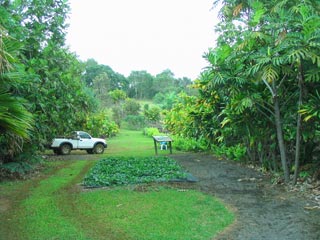
Entrance to Amy Greenwell Ethnobotanical Garden,
Hawaii, July 2010 |
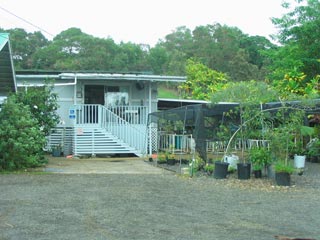
Administration Buliding, Amy Greenwell Ethnobotanical Garden,
Hawaii, July 2010 |
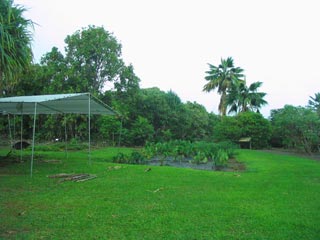 Looking across an open space to the taro pond (centre),
Looking across an open space to the taro pond (centre),
July 2010 |
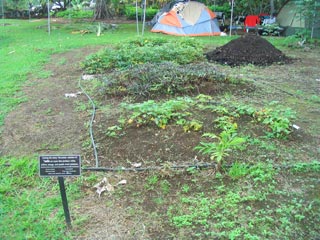
Kumara garden. The sign reads: "Among the many Hawaiian varieties of 'uala are types that produce white, yellow, orange, and purple sweet potatoes" |
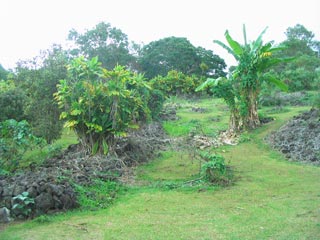
The stone walls are remnants of the ancient Kona Field System, a nework of gardens that covered about 800 sq km of this part of the Kona coast. |
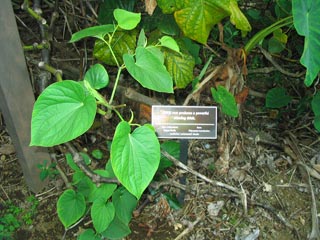 'awa. Piper methysticum: The sign reads: "Awa root produces a powerful relaxing drink". This is the pan-Polynesian kava, related to the NZ kawakawa.
'awa. Piper methysticum: The sign reads: "Awa root produces a powerful relaxing drink". This is the pan-Polynesian kava, related to the NZ kawakawa. |
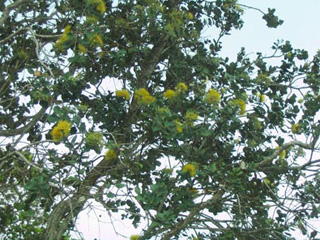 'Ōhi'a, Metrosideros polymorpha, in flower 'Ōhi'a, Metrosideros polymorpha, in flower
This tree is closely related to the pōhutukawa,
and evolved from seed blown from Aotearoa. |
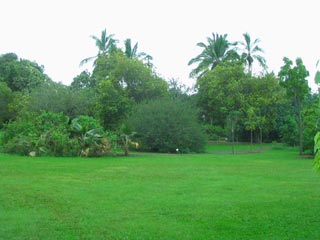
Lawn and open space, with the pervasive coconut trees visible in the background. |
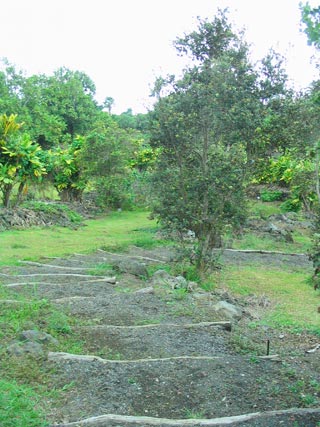 Steps on path leading to upper sections of the garden Steps on path leading to upper sections of the garden
July 2010 |
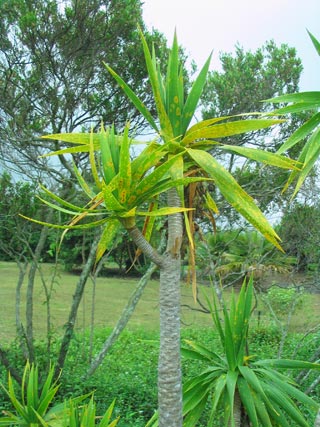
Hala pepe, Pleomele hawaiiensis. The sign for this plant reads: "The dried leaves of hala pepe were bundled to make rain capes" |
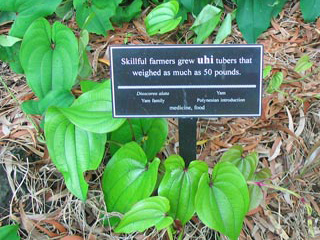 Uhi, Dioscorea alata (true yam); the sign notes that this plant was a Polynesian introduction, and used for medicine as well as food. Uhi, Dioscorea alata (true yam); the sign notes that this plant was a Polynesian introduction, and used for medicine as well as food.
|
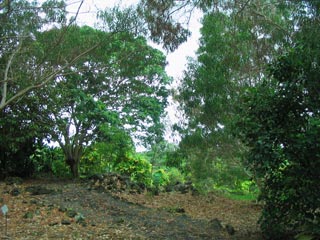
Pathway leading to upper part of garden, beyond the stepped section. Note more of the Kona Field System rock walls in the left foreground. |
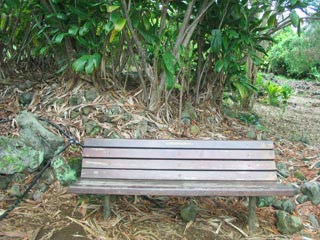
A garden seat near the top section of the garden gives a welcome respite to the climber!
|
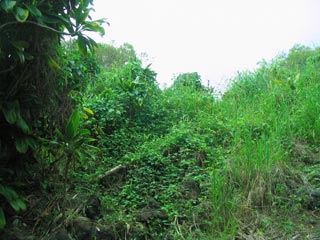
The uppermost level of the Garden was overgrown and undeveloped when I visited in 2011. |
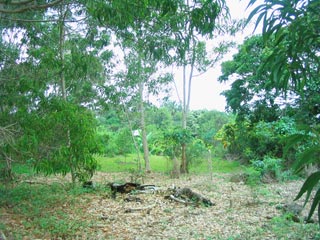
A clear space with a young koa (Acacia koa) tree on the left.
|
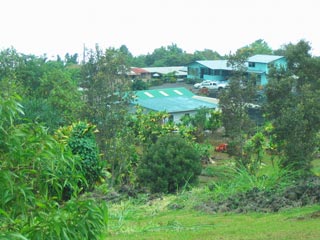
A view from- near the topmost level, looking down towards the administration buildings and nursery. |
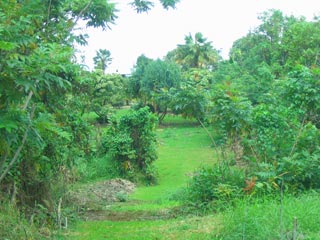 Another view on the way down from the top. Note the remnant of a Field System
rock wall in the left foreground. Another view on the way down from the top. Note the remnant of a Field System
rock wall in the left foreground. |
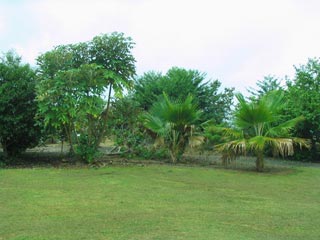
More lawn and open space on the lower level.. |
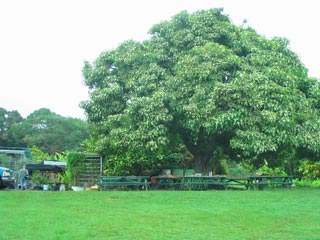 Nursery on left; the picnic tables under the tree were being used for a sugar-cane workshop when we visited. Nursery on left; the picnic tables under the tree were being used for a sugar-cane workshop when we visited.
|
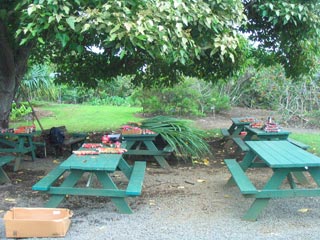
Close-up of some of the tables under the tree -- some of the sugar cane being divided for propagation is on the one in the left foreground and the one behind it. |
ONE PERENNIAL REQUEST! Since our change of server some time ago, we have noticed missing links on quite a few pages. Some of these are due to a mysterious and arbitrary change in code which seems to have happened at the time of the switch to a new server, but others have resulted because another site has taken down a linked page, or shifted it to a different URL. We correct these errors as we encounter them, or after they have been reported by a reader. There are probably more requiring attention. If you find a link that doesn't work (or takes you to the wrong place), or notice that a photograph is missing, please let us know: temaarareo at gmail.com, or kupu at temarareo.org.
Hoki atu ki runga - Return to the top of the page
For the record ... (Archived News Bulletins, May 2008-July 2018)
June/July 2018
One new page, updates to others, and additions to the bibliography.
May 2018
Our tenth anniversary; several new pages and others updated, but retrospective commentary postponed.
April 2018
Two new pages and updates to others.
March 2018
Two new pages, a revision of the page for taro, and a start made on adding in sections on the use of Maori plant names in Biblical translations.
February 2018
New pages, some statistics on where our readers come from (or where their computers say they are based) and what pages they are looking at. Also some notes on changes to the botanical names of ferns formerly included in the genus Blechnum.
January 2018
Seven new pages, several updates, and some notes about the puriri tree.
December 2017 Waitangi Tribunal, computer malfunction, invasive weeds, and a few new pages!
February 2016 General update / Eleven new pages / How to tell a taro from a Xanthostema / Peltate leaves / Thanks to NZ Plant Conservation Association members for more photographs.
December 2015 General Update / Thanks to photographers associated with the NZ Plant Conservation Network / Links to obituary of John Sawyer, new pages, and information.
March/April 2015 General Update / Links to new pages and information.
August 2014 General Update / New pages and information / New book on Taro
September 2013 General Update / Going Virtual
26 April 2012 Visit of Prof Will McClatchey & Dr Peter Matthews
25 August 2011 Visit of Ms Seiko Furuhashi
15 June 2011 "The Event!"
9 May 2011 Visit of Ms Shelley Arlidge
16 April 2011 Visit from Waikato Branch NZ Tree Crops Association
6 February 2011 Visit of Drs Jeremy Evas and Te Taka Keegan
25 January 2011 Visit of Grover and Mari Stock
10 November 2010 Visitors from Bratislava & Canberra
7 November 2010 Changes to website, visitor from Harvard
31 July 2010 Updates; visit to the Any Greenwell Ethnobotanical Garden, Hawaii; visit by Waikato Branch NZ Tree Crop Association; visit by the Waikato Botanical Society; general news
15 March 2010 Rain, frost, new pages
15 January 2010 Rain, progress, pineapples and blackberry (with pictures!)
24 May 2009 Progress and penury
6 February 2009 Plans and developments
15 May 2008 Launch of the prototype site
Hoki atu ki te rongo o te wā -- Back to current bulletin.
June/July 2018
These months have come and gone with a further slowing-down of activity, alas, and Matariki 2018 has passed without my having completed that ten-year "retrospective commentary" mentioned in the notes for May. August perhaps will see that idea become a reality! Nonetheless, we did finish one new page, on ngaio (incorporating both the Māori and Eastern Polynesian versions of that word), thanks to a query from Robert Vennell of the Auckland Museum. Revisions were also made to the pages for Māori poroporo (including a new section on poro kaiwhiri, the pigeonwood (Hedycarya arborea) and Proto-Polynesian *polo, along with the pages combining Eastern Polynesian *taraire, Proto-Polynesian *talo, and Proto-Polynesian *kaualiki respectively and their Māori reflexes. A few new references were also added to the bibliography. We are grateful Mike Thorsen, Jeremy Rolfe, Peter de Lange, and John Barkla, of the NZ Plant Conservation Network, along with Kim and Forrest Starr of Starr Environmental in Hawaii, for permission to use their photographs.
Hoki atu ki runga - Return to the top of the page
May 2018
This month we celebrated the tenth anniversary of the launch of this website (in prototype form), on May 15th 2008. I had intended to write a retrospective commentary to mark that occasion, but alas other concerns have had to take priority. Look for it some time in June, as a prelude to Matariki! However we have completed some new pages, on māhoe (Māori and Hawaiian versions), hinahina / *sinasina (likewise), taraire (Māori and Eastern Polynesian referents), Māori kōwhai, and Proto-Polynesian *kōfai. Minor revisions have also been made to the pages for whara, aka, and Proto-Polynesian *kaualiki, and a cross-reference to rangiora (a name originating in Aotearoa, alternating with pukapuka) has been added to the index page. As always, we are grateful to members of the NZ Plant Conservation Network, this month Mike Thorsen, Jeremy Rolfe, Peter de Lange, Gillian Crowcroft, John Barkla, Wayne Bennett, and the late John Sawyer, together with Kim and Forrest Starr of Starr Environmental in Hawaii, and "Bogdan", a contributor to the Wikipedia public domain website, for permission to use their photographs.
Hoki atu ki runga - Return to the top of the page
April 2018
The work on updating pages and removing bugs has continued, with further work on the page for taro, substantial revision of the page for aute, and missing links restored to the page for maikaika. The pages for ongaonga, ramarama, and Proto-Polynesian maile have all been revised and information and examples added about the use of the words to designate plants mentioned in the Bible. Two completely new pages mean that the backlog from what was planned in 2016 has now been cleared: these are the pages for Proto-Polynesian *tala-qa-moa and its Māori cognate taramoa. A section has been included on the use of the Maori word as a substitute plant name for a variety of thorny and prickly plants mentioned in the Bible. We are once again grateful to members of the NZ Plant Conservation Network, this month Mike Wilcox, Jeremy Rolfe, Mike Thorsen, John Barkla and Wayne Bennett, also to Kim and Forrest Starr of Starr Environmental in Hawaii, and the contributors to the public domain websites from which some other illustrations have been drawn, for permission to use their photographs.
Hoki atu ki runga - Return to the top of the page
March 2018
The page for kauri has been updated, and a new section added on the use of kauri as a plant name in the Bible. An enquiry from Hawaii was the stimulus for a thorough revision of the page about taro. The text has been greatly augmented, the photographs have been enlarged, the format has been updated from the 2011 to the post-2014 style, and a new section has been added about how the word has been used in the Māori translation of the Bible. Although taro is only one of more than a dozen Māori plant names to appear in Te Paipera Tapu, it is unique in both its frequency (over 400 appearances), and in the scope of its use. Further progress has been made in clearing the backlog from 2016, with the addition of pages for Proto-Polynesian *poa (a variety of yam) and its Māori cognate poapoa, the New Zealand jasmine, Personsia heterophylla. Once again we are grateful to members of the NZ Plant Conservation Network, in this case Jeremy Rolfe, Mike Thorsen and Wayne Bennett, for permission to use their photographs.
Hoki atu ki runga - Return to the top of the page
February 2018
Nau mai ki te Tau o te Kurī. And perhaps also the Year of the Pūriri, if the Ngapuhi groups can agree to combine their forces and negotiate a satisfactory settlement with the Crown. If not, perhaps it will be te tau o te mokoroa instead -- see the new page on the Pūriri, a very important tree albeit without a verified tropical Polynesian name, for more information. Some more analytics: Last year the top 5 countries with identified visitors were Aotearoa (66%), The United States (11%), Australia (3%), China (2%), and the United Kingdom (1.3%). So far this year the first three have retained their rankings, with the United Kingdom and India in joint 4th place (1.5% each). Mobile phones continue to gain on desk tops, up to 38% (to desktops 55%) by the end of this month.
Te Rā o Waitangi ~ Waitangi Day 2018. I have been looking at Google Analytics and have discovered that, among other things, this page is read relatively often; over the last year it was 9th most accessed overall, and so far this year, perhaps because there is at last likely to be some recent news in it, it has jumped to 4th. The most popular page, apart from the home page, has been and remains the page for the Māori word poroporo. Why this should be is something of a mystery, but it has been top of the list month after month for years. Other consistently popular pages have been those for kauri, whara, aute, and taro (Proto-Polynesian *talo), along with the general introduction, and those on the history and evolution of the plant names. The top 10 or 12 pages account for about two-thirds of the visits; we are hoping that a more frequently updated news page may encourage more exploration. Last year 62% of the visits were via desktop computers; so far this year this has dropped to 57%, with mobile phones jumping from 31% to 36%, and tablets steady on about 7%. Fortunately most of the pages prepared from 2014 on are fairly mobile-friendly, but some of the earlier pages may not be so easy to read on a mobile phone. We are slowly shifting these to the new format, but it will be quite a while before we can finish this "migration". Please bear with us in the meantime!
From time to time new research results in a change to botanical names for one or more of the species included in these pages. In the past we have simply corrected these in the entries for the plants concerned, but from now on we will announce the changes in these news bulletins, as some very old-established Latin generic names are being consigned to oblivion, and when updated the entries on this web site will have a name quite different from those in many dictionaries and plant lists. The latest changes result from work on the ferns in the Blechnum family (Blechnaceae). Those included in Te Māra Reo are on the pages for *piu and piupiu -- Blechnum procerum becomes Parablechnum procerum, B. novaezelandiae becomes Parablechnum novaezelandiae, and B. discolor becomes Lomaria discolor. The other fern in this group affected is listed at present only on the index page: the former Blechnum fluvatile (kiwa) becomes Cranfillia fluvatile.
Hoki atu ki runga - Return to the top of the page
January 2018
Seven more pages from the 11 waiting in the wings at the beginning of 2016 have now been added: those for Proto Tahitic *raupo, and its Māori reflexes raupō and raupō taranga, along with Proto Nuclear Polynesian **kiekie and **aka, and their Māori counterparts kiekie and aka, respectively. We are thus now well over half way to catching up, in a manner of speaking. These precipitated seven more linked pages which are now up in minimalist format (see the list in the preamble to this page, above). The index page has been updated, some additions made to the bibliography, and the missing photographs and associated links have been added to the Evolution page.
We recently had an enquiry from someone interested in the origin of the name pūriri, the tree known botanically as Vitex lucens. There isn't a page for the pūriri yet, but its alternative name, kauere, is on the list. The name "Pūriri" seems to have originated here in Aotearoa, and applies exclusively to the pūriri. The tree does feature in several proverbs, in several different guises. My giving it an etymology at present would be pure guesswork, but in subsequent correspondence some interesting metaphorical leads (which we'll follow up) have been suggested. The other name is used on the East Coast, and it's quite possible that its use pre-dates that of the name Pūriri. Some linguists link it to the Rarotongan word auere. Its presence on the East Coast would give some plausibility to the Rarotongan link, but the only thing that the plant of that name has in common with the Pūriri would seem to be its dark-coloured berry. (The Rarotongan auere is a tropical shrub, Grewia crenata, related to the houhere -- as possibly also is the Rarotongan name, because I've seen it recorded by a reliable source as au'ere.) So in its kauere guise the Pūriri might possibly have linguistic links to Rarotonga (although this is doubtful), but as Pūriri it seems definitely to be home grown!
Hoki atu ki runga - Return to the top of the page
|
December 2017
We began 2016 with great ambitions, which seemed well on track in February, with 13 new pages added to the site and half a dozen more in an advanced state of preparation. Then the world outside the garden intervened, in the form of Te Paparahi o te Raki -- the Waitangi Tribunal hearings on the claims of several northern hapū and iwi or which expert opinions on issues connected with language policy had to be prepared by the person responsible for most of the web pages. That took up a good chunk of 2016, and then an expensive component of the computer failed, and it was not until near the end of 2017 that we have been able to afford to replace it. Keeping the invasive plants, especially the moso bamboo, under control has also consumed a great deal of time, money, and the fading energy of the chief gardener. Fortunately other family members and friends have helped greatly in the battle with the unwanted herbage, and also supplied the expertise to get the computer system up and running again once the vital component was obtained.
Two of the 11 pages still in preparation in February last year have at last been added to the site and the index, along with one other. They are those for Proto-Polynesian *kofe and its counterparts in Aotearoa, kohe and kohekohe (jointly), along with another "twin" page, for Proto Central Eastern Polynesian *kākaso and its Māori reflex kākaho. The first two contain also a lot of information about words originally referring to varieties and uses of bamboo, many of which found their way to Aotearoa even though the bamboo did not. This was partly inspired by our ongoing struggle with the moso bamboo, and the visit of members of the NZ Bamboo Society to Te Māra Reo for their Spring 2017 meeting.
A paragraph has been added to the introduction to the name index page pointing out that some of the plants in addition to their generic names had a large number of terms relating to
varieties and uses associated with them. Chief among these are the breadfruit (Proto-Polynesian *kulu), taro (Proto Polynesian *talo), bamboo (Proto-Polynesian *kofe, from which Maori kohe originated), and kumara (Proto Eastern Polynesian *kumala). The history of many such words which are plant-related but not always plant names is recorded on those and other pages.
Hoki atu ki runga - Return to the top of the page
February 2016
Amendments have been made to some pages, a few more broken links repaired, and many new pages are in preparation. The first of these were ready for transfer at the end of this month and have now (early March) been transferred. These pages are in various stages of completeness, but all have the essential botanical information, many have a little additional information, and some have pictures. It takes quite a while to prepare a page as all the information has to be checked, including botanical names which are occasionally out of date in some key sources, and photographs sourced and prepared for the web. And then there is the narrative to add, often from many pages of notes. Rather than keep delaying until everything planned for a page has been completed, I have decided that the common-sense approach is to work towards getting get the basics attended to for all the words in our lists, and then go back and fill in the details later. The 13 pages added in this batch are those for ongaonga (Proto-Polynesian *hongohongo); whau and whauwhau (Proto-Polynesian *fau); houhere (Proto-Polynesian *fausele); kohe (Proto-Polynesian *kofe); māota (including Proto-Polynesian *maqota); kōhia (no direct Proto-Polynesian counterpart, but possible links to Proto-Polynesian *kofekofe);
and ramarama (Proto-Polynesian *lama).
There are 11 more now in preparation.
We remain deeply indebted to the members of the NZ Plant Conservation Network who have generously allowed us to use their photographs, and in some cases supplied unpublished ones to fill some gaps. In addition to those people mentioned in the news for December 2015, Mike Thorsen has given us permission to use his photographs; one appears in the page for ongaonga (link above). Additional material will be added to pages designated to be "under construction" when the opportunity arises, but priority will be given to producing pages with the botanical information for all the names on our list that are not yet represented on the site. However, please let us know if you would like information added to an existing page, or a currently absent page to be added, ahead of schedule. We'll try to oblige!
For those who have read the question at the end of the page about *talo (taro), if you look carefully at the photographs you will see that the leaf stalks of the Xanthosoma plants are attached right at the point of the "V" indentation on the leaf. The true taro (Colocasia esculenta) leaves are attached nearer the middle, a little way below the "V". The technical term for this is "peltate", from the Latin word "pelta", a crescent-shaped shield. Peltate leaves, like those of the Colocasia, are attached
near the middle, between the upper and lower margins; the Xanthosoma leaves are non-peltate.
I'm grateful to Dr Peter Matthews for identifying the Xanthosoma pictures from my collection of photographs of plants I have encountered in the Philippines.
Hoki atu ki runga - Return to the top of the page
December 2015
A lot of research and some exploration (in Aotearoa and Samoa) has been done since the last update, with about a dozen new pages in preparation and others revised. We hope to have the new pages finished soon. Meanwhile we are very grateful to have permission from a number of members of the NZ Plant Conservation Network to use their photographs on pages where we do not have enough or any suitable photographs of our own. These have been incorporated in many of the pages in preparation, and in the revised (and considerably expanded) pages for *fara, whara (including harakeke), and wharawhara, and cognate words, which are now up on the web. These people all have our grateful thanks: Wayne Bennett, Jonathan Boow, Jesse Bythell, Gillian Crowcroft, Peter de Lange, Jeremy Rolfe, and the late John Sawyer. We were saddened by the news of John's sudden death on 6 November, and extend our condolences to his family and friends. There is an obituary on the NZ Plant Conservation Network's website, outlining John's remarkable contribution to the conservation and knowledge of NZ native plants during the twenty years he lived in New Zealand; this including being one of the co-founders of the NZ Plant Conservation Network -- an organization which we would urge anyone interested in NZ native plants to join by becoming a member.
Hoki atu ki runga - Return to the top of the page
March/April 2015
A few minor adjustments have been made since the last major update of the site in August last year, and one major change -- a new home page (the old one is now a "read more" page linked to the revamped one), along with a quick time-travel page, also linked to the home page, based on the brochure prepared a few years ago for visitors to the tangible garden.
New plant pages have been added, many in draft form so that the essential information will be available on the site more promptly. It often takes a long time to assemble the photographs and obtain and check the information included in the longer entries, so we have decided to start routinely putting up pages when we have the linguistic information and some basic information about the plants, rather than delay sometimes for months until a more complete version is ready. The new pages put up on April 10th are for Māori Hangehange, Hīnau, Makomako, and Maire, Proto-Polynesian *Hange, *Mako, and *Maile, and combined Māori/Proto-Polynesian (*)Aute (including *kaute, *siapo, matahiapo, *malo, and maro), (*)Mairehau, (*)Manapau, and (*)Pau. Two more pages feature locally created and acquired names, Koromiko and Ōriwa.
Hoki atu ki runga - Return to the top of the page
August 2014
August 2014 has been an exciting month for the web site. We have now completed our 100th on-line "name" page, with nine new pages bringing to 49 the number of pages devoted to Proto-Polynesian names, the plants they denoted, along with plants bearing reflexes of those names in some modern Polynesian languages, and 53 devoted to the plants bearing Maori names derived from earlier stages in the evolution of the language. Not yet half way -- still another 153 to go (unless more names or plant references are discovered!), but getting there.
At long last the pages on the web site can be accessed directly through the "temarareo.org" address. We are also slowly editing older pages and converting them into a modified format including the pull-down menu for getting to other parts of the site, and which also happens to be reasonably mobile-friendly.
New pages are also starting to appear-- the latest are those for Proto-Polynesian *Malili, *Tawa, *Lewa, and *Kulu, and their Māori reflexes Māriri, Tawa, Tawāpou, Rewarewa, and Kuru. Substantial revisions have also been made to the page for Māori Poroporo and the explanation of the use of the Chinese characters 德馨 on some pages. All these pages and 12 others have been transferred to the new format with the pull-down menu and more accessible page design. A few have only basic linguistic information at the moment; we hope to prepare more of these in the near future, to fill the complete gaps in our documentation. The garden itself has suffered from the recent frosts, and we are still uncertain as to the long-term future of the physical garden. However the virtual garden may well grow more luxuriantly; once we have the Māori names covered, we may include some more Samoan and Hawaiian reflexes that are not paralleled here as part of a wider garden of Tāne mā. Meanwhile I have been able to spend a few days in Samoa, and photograph a few of the plants which do share their names with counterparts in Aotearoa.
Many plant names have come to Aotearoa via Samoa, and several dozen probably originated there. On a recent visit to Samoa I was able to photograph two Mālili (Terminalia richii), a very tall forest tree, native to Samoa and now critically endangered, one in the botanical garden and another on the side of a road, dramatically catching the last rays of the sun. The name of this tree may be related to the Māori word māriri "the unripe fruit of the tawa" (another tall forest tree), derived from Proto Nuclear Polynesian *malili "unripe or withered fruit" -- there is a well-established Samoan cognate reflex from this source, malili (short initial vowel), used when fruit falls before maturing. We am very grateful for HH Tui Atua Tupua Tamasese Taifi Efi for making this visit possible, and to Galumalemana Steven Percival for his help in locating the mālili and other significant plants and for facilitating a brief but very productive visit to the Botanical Gardens.
We have recently also received a copy of the book On the Trail of Taro: An Exploration of Natural and Cultural History by Dr Peter Matthews, a New Zealander who is a world authority on taro and has visited Te Māra Reo. It has just been published by the National Museum of Ethnology in Osaka, Japan. It is a fascinating story replete with scientific data of the cultivation of taro and its spread by horticulturalists from Nepal on the one hand and Yunan, China on the other, in prehistoric times, reaching New Zealand from the Pacific in the early years of Maori settlement. However, the original strains have over the last two centuries been partly replaced by introduced varieties from China and elsewhere, although the older varieties also remained in cultivation. Taro is a very resilient plant, and both older and more recently introduced varieties may be found in the wild as well as in gardens.
Hoki atu ki runga - Return to the top of the page
September 2013
It is horrifying to note that it is over two years since this page was updated. There are two reasons for this. Firstly, we have been in the process of updating many pages while at the same time shifting the site to a new server, and this has taken longer and produced more complications than we anticipated. Most of those difficulties have now been surmounted, however, and when you see this the new pages will have been loaded. There may well be some bits missing and other adjustments needed, so if you spot something apparently amiss, please let us know. Secondly, the future of the garden itself is in doubt, as without an adequate income the venture is rapidly becoming unsustainable. However, we have decided that even if we have to abandon the physical garden, the digital one will be retained, so this site will continue to grow! Some of the highlights for the last two or three years are summarized retrospectively below (with illustrations in the left-hand panel). More information, both old and new, will be added from time to time, at much shorter intervals than in the recent past!
Hoki atu ki runga - Return to the top of the page
April 2012
On April 26 we were honoured by a visit from Dr Peter Matthews of the Osaka Natural History Museum, a world authority on taro, and Professor Will McClatchey, the Director of Research at the Botanical Research Institute of Texas. Professor McClatchey, a distinguished ethnobotanist, was very helpful to us in making contacts and advancing our research when he was Professor of Botany at the University of Hawaii, and has remained a good friend of Te Māra Reo in his new capacity.
Hoki atu ki runga - Return to the top of the page
August 2011
On August 25 Ms Seiko Furuhashi from Osaka Gakuin University, Japan, visited Te Māra Reo. While she was here she was able to add to the fern collection by planting a specimen of Blechnum novaezelandiae in the section allocated to those collectively known as piupiu.
Hoki atu ki runga - Return to the top of the page
The Event. [15 June 2011]
On 15 June we held a seminar to discuss current plans and future possibilities for the garden with individuals and representatives of groups interested in native flora and ecological and environmental issues. The all-day seminar generated some very useful ideas, and we greatly regret that we have not been able to secure the resources needed to follow through on many of them.
Hoki atu ki runga - Return to the top of the page
May 2011
On May 9 Ms Shelley Arlidge, Director of the Russell Museum, visited Te Māra Reo to discuss the ideas behind the garden and plans for its development. She planted a specimen of Astelia fragrans (wharawhara) in the hexagonal "*fala" enclosure near the main gate.
Hoki atu ki runga - Return to the top of the page
Visit of Tree Crops Association, 16 April 2011
Members of the Waikato Branch of the New Zealand Tree Crops Association held a field day at "Tumanako" on 16th April 2011. Members had come to look at the fruit trees planted on the property, and also to tour the language garden. The event was reported in The Waikato and Thames/Coromandel Branches, New Zealand Tree Crops Association, Newsletter June 2011, pages 4 to 5, reproduced below.
On a dripping wet Saturday, tree crop enthusiasts numbering 19 braved the elements, dodged the V8's noise and traffic in Hamilton, and met at Richard Benton's 2 hectare property on the outskirts of Ngarauwahia. During the past 14 years of Benton family ownership, the use of the land has completely changed from an almost bare paddock with a row of 110 pine trees (now mostly gone) to a mixed forest of native and food bearing trees.
After a welcoming cuppa, Benton handed each of his visitors a leaflet outlining the stages of his "language garden" and an accompanying map of the intended 800 m winding tour of the property, arranged to simulate a trip around many Pacific islands. He then guided his visitors along the paths conducting them on the imaginary journey starting from Taiwan 5000 years ago, when Polynesian peoples began to spread across the Pacific. On the way, Benton, with his particular interest in Pacific languages, explained the concept that the names of New Zealand's native trees as we now know them, have developed down the centuries even millennia from the names of earlier, similar plants in different locations in the Pacific. In line with this concept Benton selected a dozen "stages" or places within his forest, to pause and note a particular tree and to point out the specific links. These includes those with familiar names such as kauri, kahikatea, totara, pohutukawa and manuka and others not so well-known.
Interspersed throughout Benton's forest are almost 50 planted kauris, now 12 years old and handsomely tall. We heard that the round kauri cones are female and pointed cones are male – news to some. The kauri does not have flowers. Male and female cones grow on the same tree, with a male cone emitting pollen.
Scattered among Benton's native trees are fruit and nut trees, including many kinds of olives although only one olive variety ears fruit and the Waikato – the koroneiki. Numerous figs were bearing, of note the tiny but sweet black mission variety. Figs and grapes grow well at this location.
Near the front of the property as a grove of large moso bamboo, with mature (four-year-old) bamboo stalks at least 100 mm in diameter. Bamboo is notorious for growing out of control, but Benton is fortunate that an Asian person, aware of both its potential and its needs, noticed it, remarked that it was the best stand he had seen in New Zealand and offered to tend it. He gathers the young shoots for eating, trims the roots, and as a result the stand is attractive and not at all like a common bamboo thicket. The strong bamboo can be used to certain types of construction provided is not left in the ground (where it rots). Benton has a plastic greenhouse made with bamboo stalks on Waratah posts.
On the property are one or two patches of hollow ground called borrow pits, having survived since Maori ownership. In days gone by they were used to provide course of gravel or other components to improve and warm up the soil elsewhere, where kumara were grown, perhaps across the adjacent Waikato River.
Other points of interest on the way included a bunyabunya tree, a Queensland kauri, a large Pinus pinea that will hopefully produce pine nuts, and the Hawaiian calabash gourd displaying one large gourd in progress.
Near the end of the journey the "tourists" refreshed themselves delightfully by munching on different varieties of ripe apples picked straight from the trees.
The visit was strongly educational, botany being intertwined with linguistics, history, and geography, all served on an imaginary sea voyage around the Pacific.
Thank you Richard Benton.
Hoki atu ki runga - Return to the top of the page
Visit of Drs Te Taka Keegan and Jeremy Evas, Waitangi Day 2011
We were delighted to welcome Dr Te Taka Keegan of the Computer Science Department at the University of Waikato and Dr Jeremy Evas, Director of Terminology and Policy, Welsh Language Board, who visited the garden on Waitangi Day. They came to discuss language revitalization policy and practice, and enjoyed the tour of Te Māra Reo while engaged in this task. There is a report on Dr Evas's visit to Aotearoa in Te Muka, the newsletter of the Māori Language Commission, Vol 24, No. 1, with photographs taken while he and Dr Keegan were with us.
Hoki atu ki runga - Return to the top of the page
Visit of Grover and Mari Stock 25 January 2011
Two visitors from California, Grover and Mari Stock, visited the garden with Wi Kuki Kingi, Jr, from Kirikiriroa Marae, Hamilton. Mari, originally from Costa Rica, and Grover were visiting New Zealand in connection with their work on sustainable land use and related matters. While they were here Mari planted a puka tree on the northern end of the "Nga Tamariki o Te Hapuku" fern garden. It was Wi Kuki who challenged us to "do it ourselves" when our ideas for a language garden in Manukau City were scotched by the developers of a new town centre.
Hoki atu ki runga - Return to the top of the page
Visitors from Canberra and Bratislava, November 2010
On 10 November 2010 we hosted Professor Andrew Pawley of the Research School of Asian and Pacific Studies, Australian National University, Canberra, his wife Medina, and Dr Martina Buckova, an anthropologist specializing in folk lore at the Slovakian Academy of Sciences, Bratislava. We had just started working on a section of the garden reserved specially for the children of Te Hapuku (tree ferns). After their tour of the garden, Martina was able to plant one of our newly-acquired mamaku there, and Medina and Andrew planted a kāpuka and horopito respectively along the border of this area.
Hoki atu ki runga - Return to the top of the page
7 November 2010
The 7th of November was the first of two major changeover days planned for this site: the launching of the revised versions of the key pages incorporating new headers with built in menus. Before long (we hope) this will be followed by transfer of the whole site to a new server, which will mean that all the pages will have URLs commencing "www.temarareo.org/" rather than the present much more complicated addresses [this is still "work in progress @ August 23rd].
The revision of the pages seemed to be taking an interminable time, so it is a great relief to have completed it. It should make the site much easier to get around, and the information on it easier to find. These pages have also been livened up by a lot more photographs and icons. There is a guide to the site as a whole (and the garden) in the new "Finding Your Way / Hōparatanga" Section.
On the new pages we have also abandoned the "Māori" fonts, which we had used on the ones they replace -- instead, we have specified the fonts as Arial, Geneva or generic sans serif, with inbuilt macronized characters. The older pages, including all those dealing with plants and plant names written before November 2010, are still in the old format and incorporate Times New Roman Māori and Arial Māori fonts.
We had a visit from Emeritus Professor Courtney Cazden from Harvard University in September. She was very taken with the moso bamboo (see picture at left), through which the walk to beginning of the "Time Travel" journey usually begins. This plant grows naturally in the mountains of Taiwan and so the moso grove is a good imaginary encounter with the cradle of the Austronesian languages. Two words for large bamboos have been reconstructed for Proto-Austronesian: *betung (Proto-Oceanic *botung), and *qauR, unchanged in Proto-Oceanic. The first didn't make it into the Pacific; *qaur got as far as Vanuatu and New Caledonia, and its reflexes are also found as a generic word for "large-stemmed bamboo" in many Indonesian languages. Had it reached this part of the world, it would be au in Māori. (It is remotely possible, but I suspect unlikely, that au in the sense of a pin holding a mat as an item of clothing is an echo of *qaur, as this was certainly one of the many uses of bamboo in the tropics.) The new shoot which Professor Cazden is standing beside is now a culm about 8 metres tall -- they can reach 24 metres, so ours still have a way to go!
I was very pleased to discover when reading the October newsletter of the Waikato Botanical Society that we have at least one "declining" species of native plant actually flourishing here, but I was also disconcerted to realize that we had not been treating it with due deference! The plant concerned is the northern Poroporo, Solanum aviculare, which according to an article in the October 2010 Waikato Botanical Society's Newsletter is apparently rare in the Waikato and thought by some botanists to be a "declining species". Here in Te Māra Reo it is certainly not declining -- from two original plants we brought here from Auckland via Wellington it has been carried literally from one end of the 2 hectare block to the other. We like the tree -- it has attractive foliage, beautiful flowers, provides shelter and shade for smaller plants, and (because it's rather frost-tender) is an excellent indicator of where the warmer microclimates are to be found -- so we have generally left seedlings unmolested. It's also very fast growing, and we planted some along part of our boundary with a neighbour, to replace the pine trees we had felled. However, the first thing some local people we hired to clear along the boundary did a couple of years ago was to demolish unbidden every poroporo they encountered. This was not part of the plan (they regarded it as a weed), but we would have been a little more perturbed if we had realized that the way the plant was flourishing here was not the norm!
Finally, while in Hawaii in July and on a short visit to the Australian National University in September, and with the help of colleagues in Australia, Japan and the US, I have been doing some research on the migration history of taro, both the plant and the word. This will be reported in the page for taro when I have time to write up the results of these investigations. R.B.
Hoki atu ki runga - Return to the top of the page
31 July 2010
Even more water has fallen from the heavens since the last update, but there have also been a few frosts, mostly while I was in Hawaii doing some more research, although fortunately those have not been nearly as destructive as the ones we had a couple of years ago. Perhaps warming is accompanying climate change, after all, or some of the more tender plants are becoming hardier! Over the last four months revisions have been made to the introductory, acknowledgements, biographical, index, locations and contact pages. We are planning a change in the formatting of the site which will make the main menu accessible from all new pages and from existing ones as they are revised, as well as improving the overall page layout. This should be in train by the time of the next update, but don't hold your breath! New pages have been added or revisions made for 10 Proto-Polynesian names: *halufe, *mamaku, *kumala, *kaualiki, *kava, *kiwa, *mafoe, *manono, *taraire, and *fapuku. Nine new Maori-name pages corresponding to some of these (or others) have also been completed: kawa, kawariki, kiwakiwa, mahoe, puka, rangiora, taraire, mamaku and wheki. The report of the Waikato Botanical Society's visit at the end of February has also been made accessible from the site, as well as our brief "time travel" guide for visitors. While in Hawaii I visited the Amy Greenwell Ethnobotanical Garden on the island of Hawaii, and got some very good ideas from the way they run things (this is a formerly private garden owned by the Bishop Museum, but largely dependent on private funding and the help of volunteers to keep it going), some which I hope to implement in Te Mära Reo as the opportunity arises.
Hoki atu ki runga - Return to the top of the page
15 March 2010
A lot of water flowed from the heavens in January and up to the middle of February, but in the month since then only 10 mm has fallen. However, the fifty-odd seedling trees we planted out in January and early February are faring well, although we have given a few that were looking a bit jaded some water over the last couple of weeks.
Despite the drought, some qantum leaps forward have been made. We had a visit from the Waikato Botanical Society on February 27, which enabled us to inaugurate the "Time Travel" tour -- this seemed to interest everyone who took part. We were lucky to have had a visitor from Canada, Mr Noel Francisco, who did the walk a couple of weeks earlier. This allowed us to have a very helpful trial run. Another visitor, Mr Matthew King, shot 11 rabbits and a possum, which was also greatly appreciated.
Eleven new pages have been added to the web site since January 15: six Proto-names (*renga, *piu, *ponga, *feki, *lata, & *kisi); four Mäori names (rengarenga, piupiu, ponga, & kokihi), and a page about how the plants are (or will be) identified with "cylinder" and "flag" labels (this is linked to the "Finding your way around the garden" page). These signs are now in place for all the significant plants included in the "Time Travel" series, and a few others. We have bought a laminating machine and are printing the labels ourselves, which has cut the cost of preparing the signs by about 80%. Minor and sometimes major revisions have been made to many other pages on the web site, and further work on the plant names not yet dealt with is under way. The biggest headache right now is not the lack of water, but the absence of an inward cash flow :).
Hoki atu ki runga - Return to the top of the page |
|

